In this article, I’ll dive into the world of interactive content, a powerful tool for SaaS businesses. I’ll kick things off by explaining what interactive content is and why it’s relevant to software as a service organization.
I’ll explain how to map IC to each stage of the buyer journey, share my five content experience best practices for SaaS businesses, and finish by sharing a little bit about ROI calculators.
My name is Diego Gomes, I am the CEO and founder of Rock Content, and in this article, I'm going to discuss interactive content ideas for each stage of the buyer journey.
Agenda
I'm going to cover:
- What is interactive content?
- Why interactive content is relevant to SaaS businesses.
- How software as a service companies are adopting interactive content across the journey,
- Some best practices, and
- To finish, I'm going to share a little bit about ROI calculators, a very powerful tool for software as a service businesses.
Interactive can transform SaaS buyer journeys
Here you can see some recent news about Oracle launching their cloud calculator, where it compares its prices to AWS.
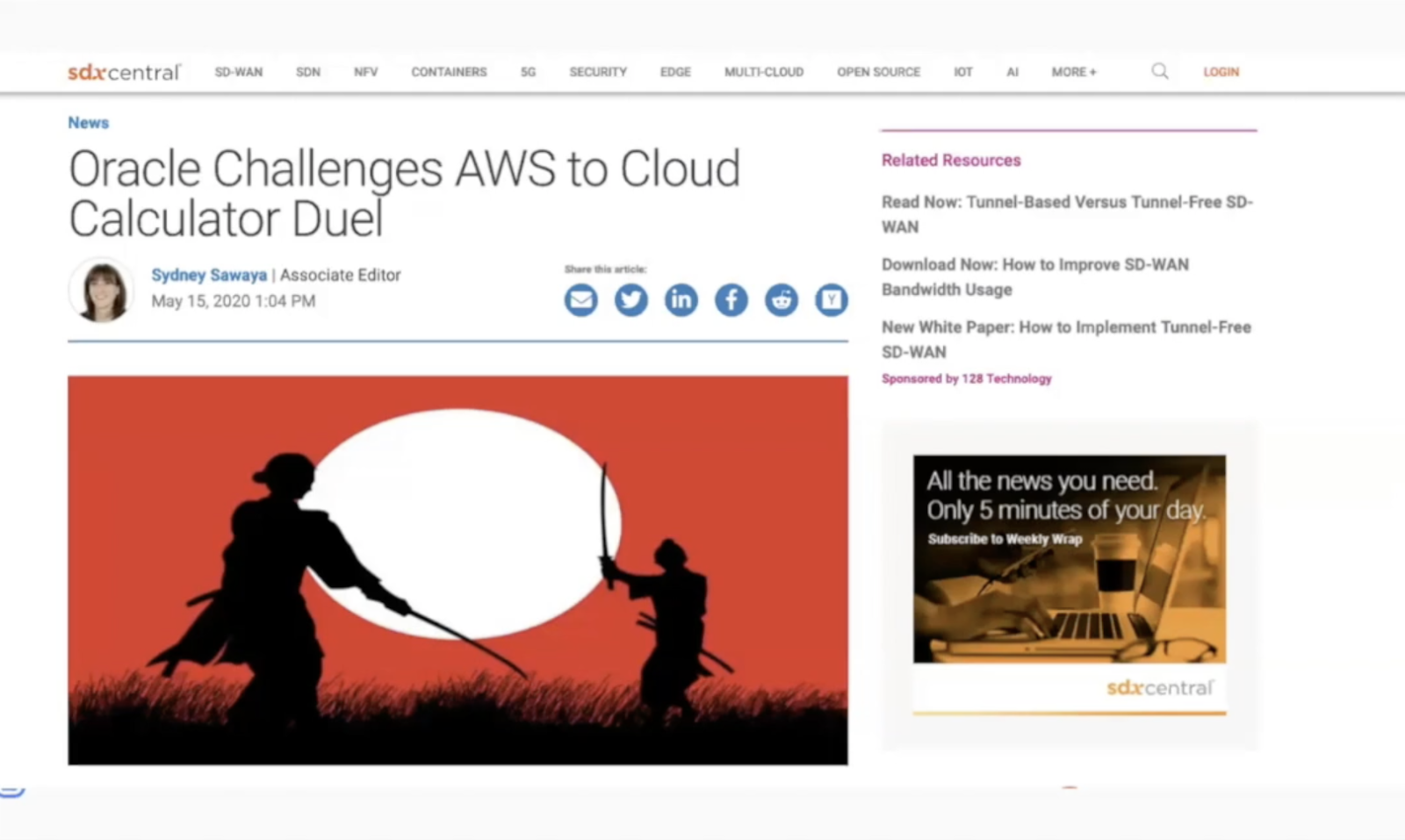
Using the tool you can see how much savings you can make, estimate the size of your bill, etc. It's a pretty interesting tool and I invite everyone to check it out. I think this is one of the best examples of the kinds of opportunities that interactive content brings to companies in our industry.
I'm a big believer in interactive because I know they can transform the buyer journey. At every step of the journey, there is an opportunity to leverage interactive content to gather data, collect contact information, and provide more value to your prospects.
What is interactive content?
It's pretty simple. These are digital experiences created for participation engagement, and not just passive consumption.
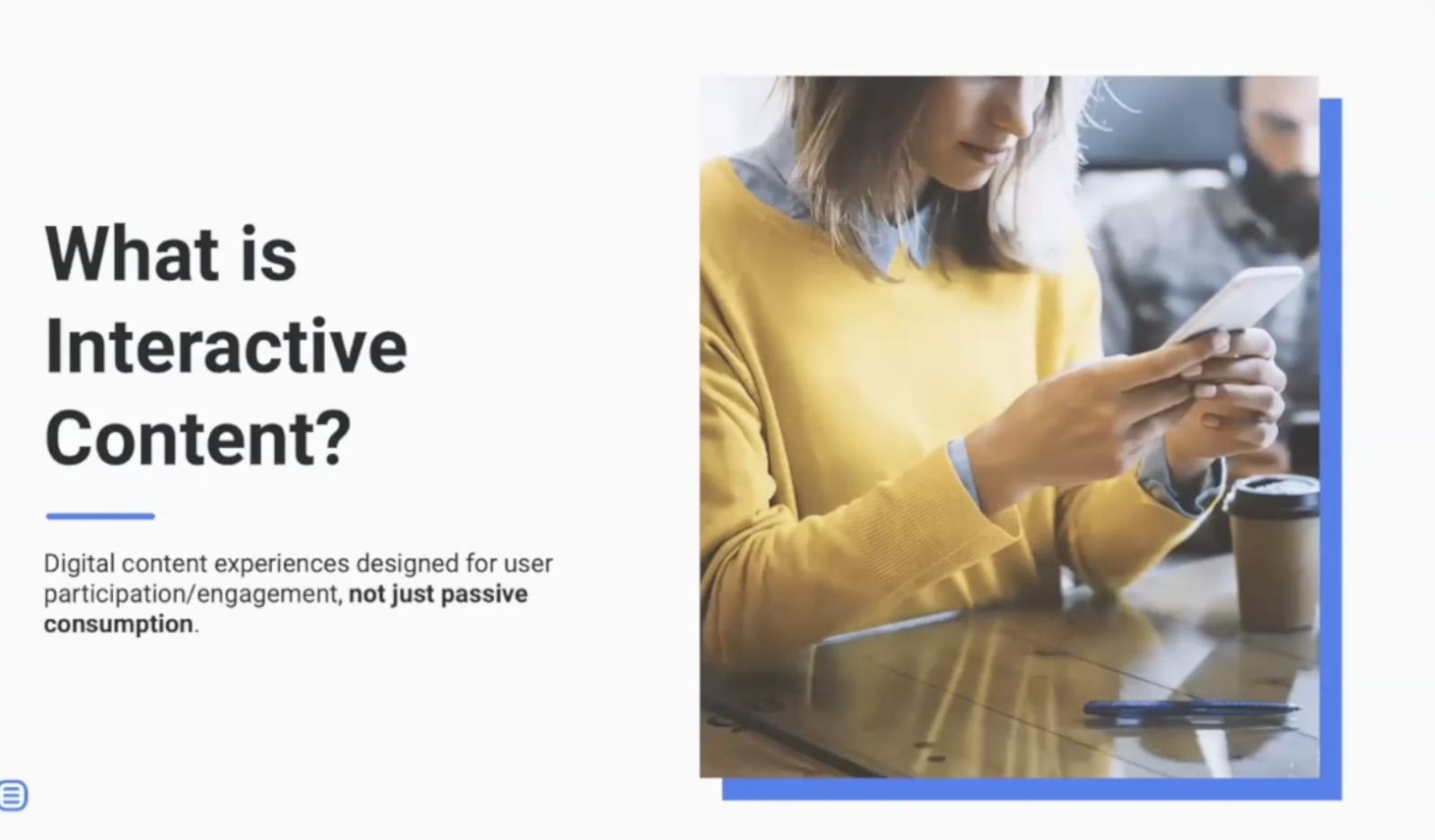
Typically interactive experiences have a feedback loop - the user does something and gets something personalized in return.
Types of interactive content
There are several types of these:
- You can create assessments to evaluate how your user compares to a set of users.
- You can leverage calculators, I think the Oracle calculator is a very good example.
- Interactive ebooks where you can open your ebook content and ask to download only a certain part of it.
- Interactive infographics
- Interactive white papers
- Lookbooks and tours are pretty interesting for companies that have a portfolio to showcase
- Resource libraries and content hubs.
- Solution finders is another very interesting format for companies that have a broad variety of formats, and
- Quizzes where you can BuzzFeed style but with personalization for your specific persona.

Why is Oracle doing this now? (And why you should too…)
Why is Oracle doing this now? Why do I believe SaaS businesses can leverage interactive in a very wide variety of scenarios? And why do they generate great results? I'm going to start with some statistics.
Engagement
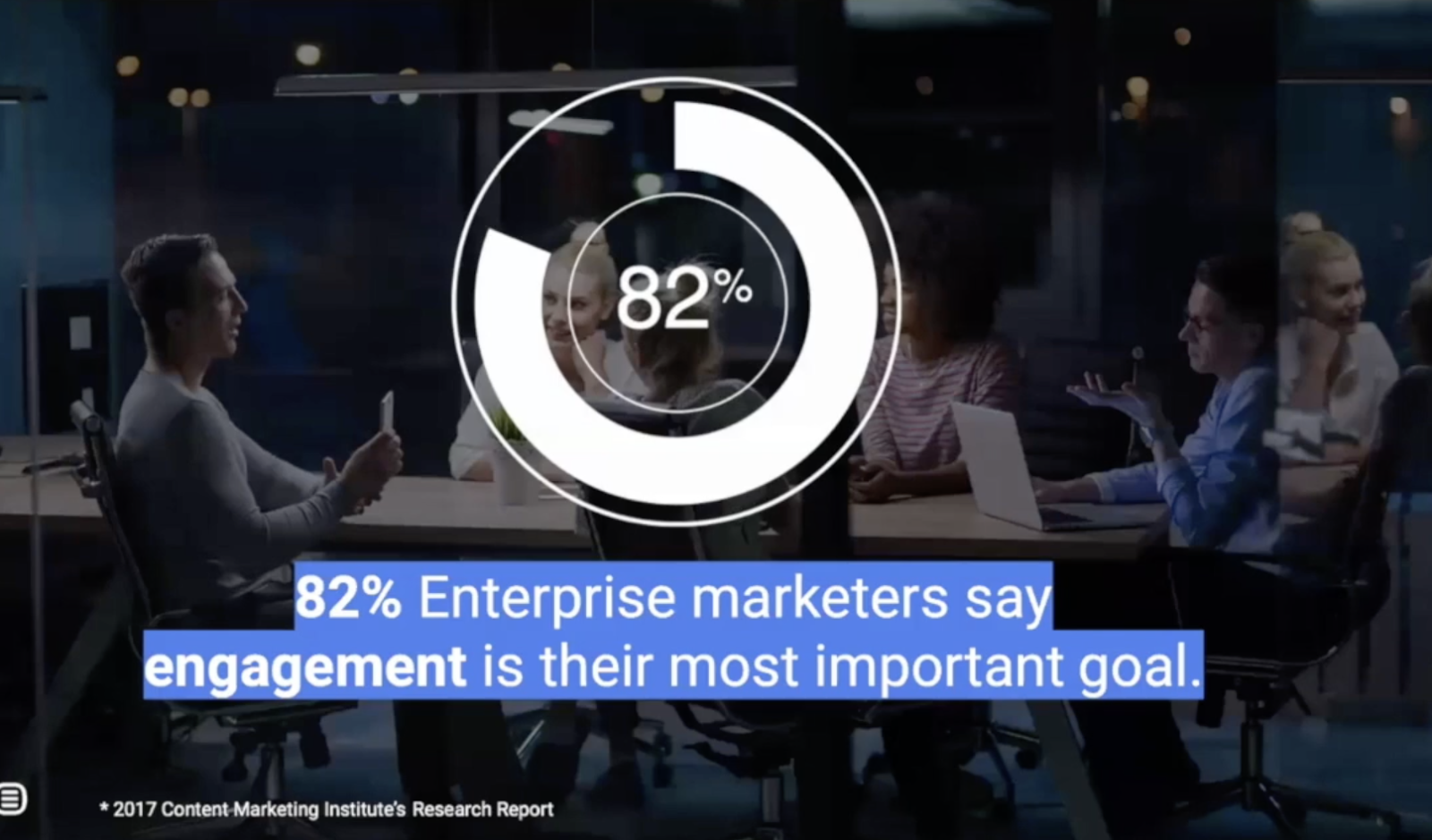
Today 82% of enterprise marketers say engagement is their most important goal. It's challenging to fight for attention these days and interactive is a great way to get that engagement.
Efficacy
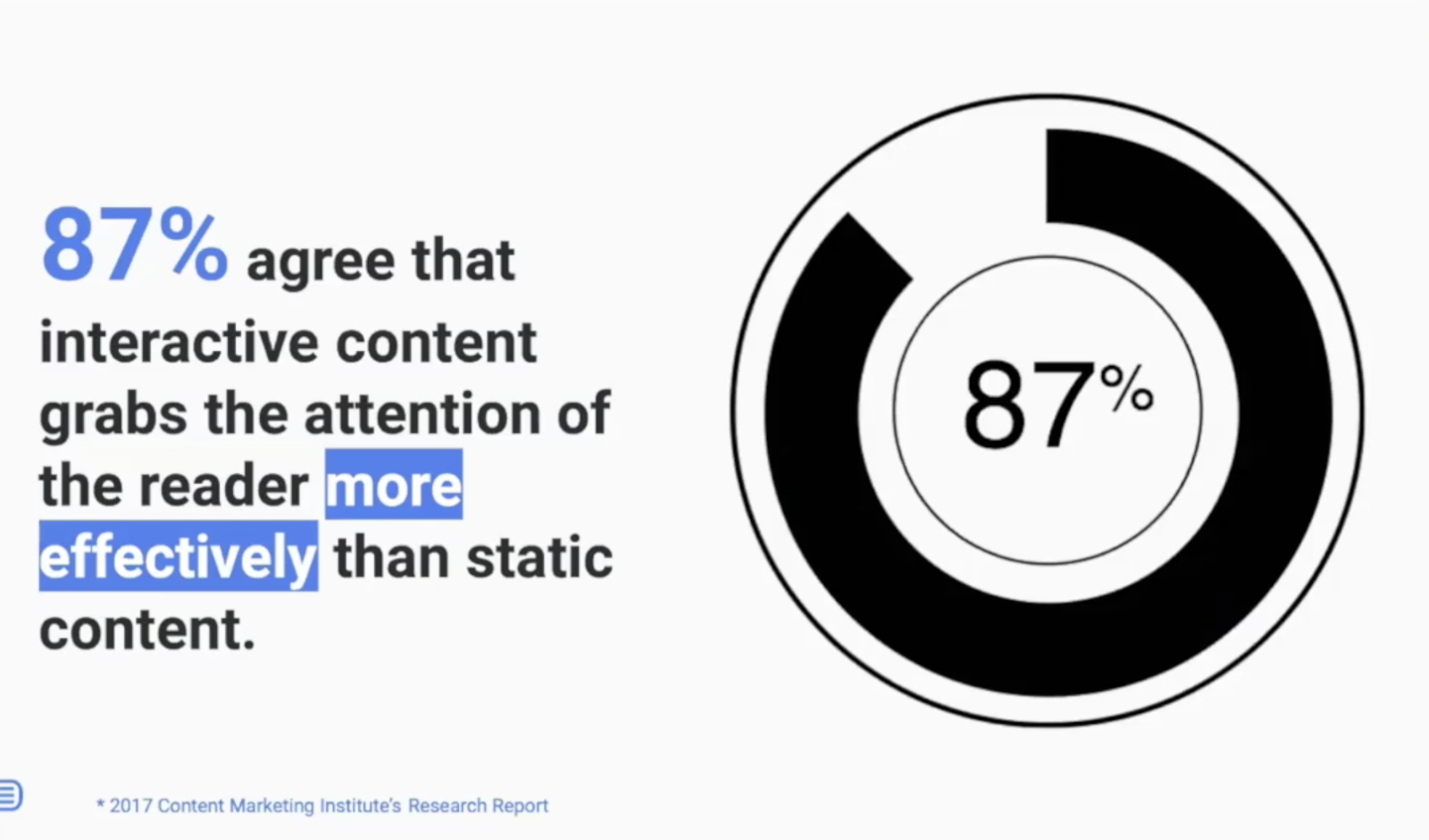
Also, interactive content grabs attention way more efficiently than a typical blog post or just a PDF. These feedback loops that I mentioned bring outstanding results.
Preference
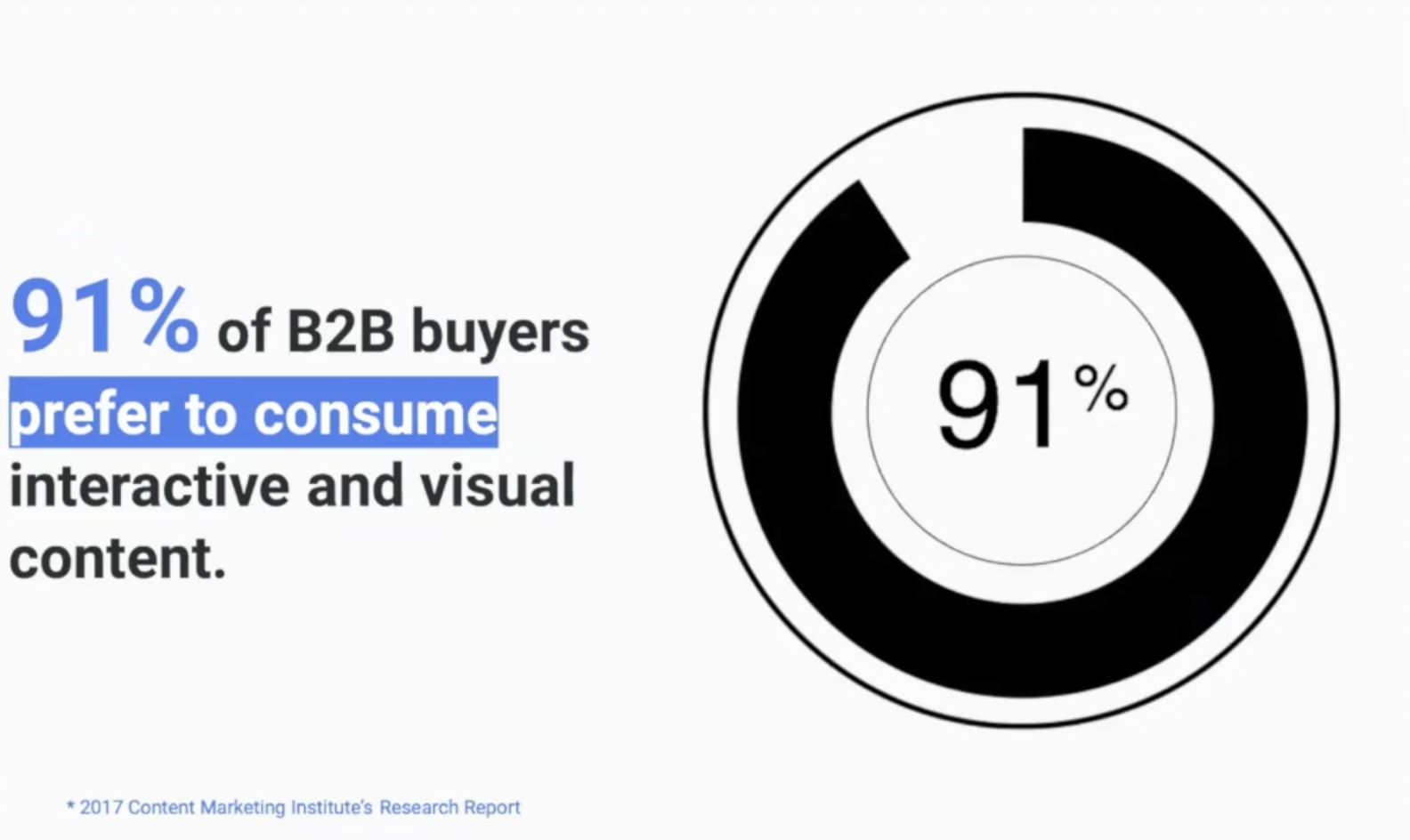
Another key factor is 91% of B2B buyers choose to interact with visual content over text and static formats.
2x more conversions
It typically converts 2x more than static landing pages, than traditional or some might say boring experiences.

Lead quality
Finally, the biggest challenge is high-quality leads.
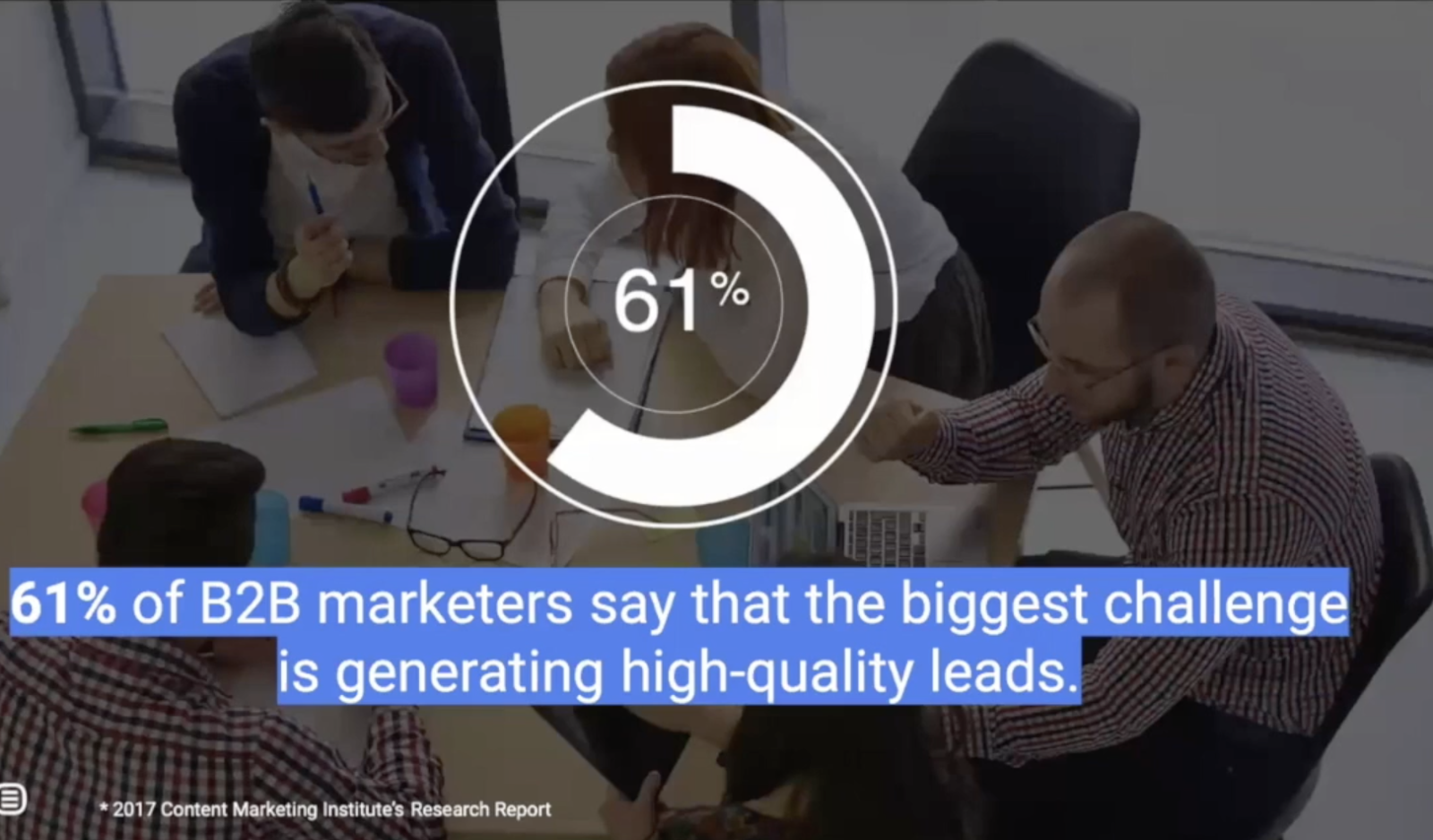
I'm going to show a few examples of how interactive sources some of our best leads here at Rock.
Interactive for SaaS: Map to the buyer’s journey
The secret for interactive content when it comes to SaaS, and this is advice that's valid for any industry but in SaaS, there's even more opportunity if you use your interactive experiences to map to the journey.
Customer journey
Here's the classic buyer’s journey, it starts at discovery, research, selecting a buyer, buying, adopting a solution, retaining your customers, and getting the referrals loop.
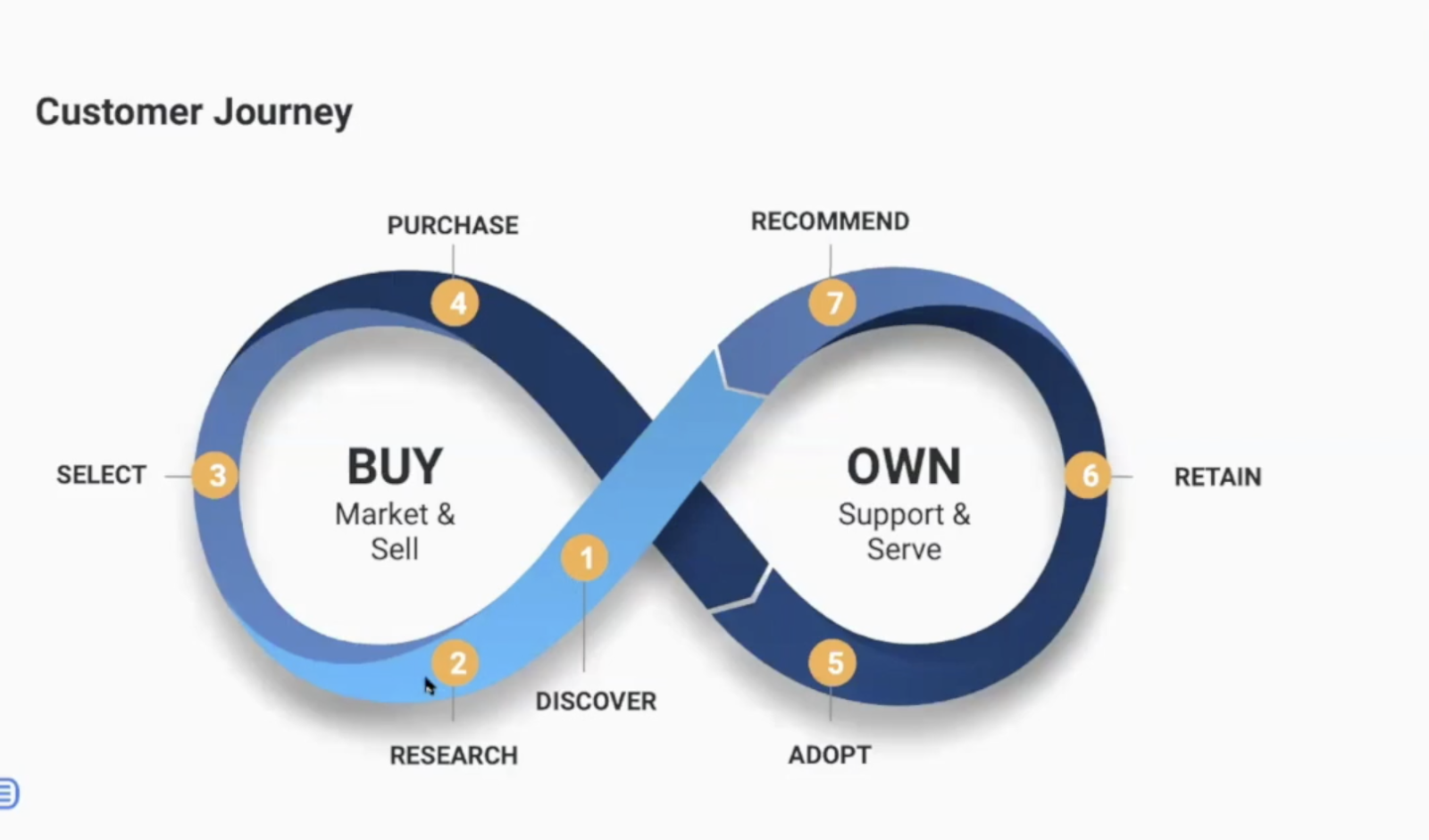
The goal here is to turn to content marketing and content marketing is widely embraced by our industry. Every SaaS company I know has a blog and launches ebooks but you can turn this content into experiences, richer interactions where you can capture data and you can automate some pieces of your sales funnel.
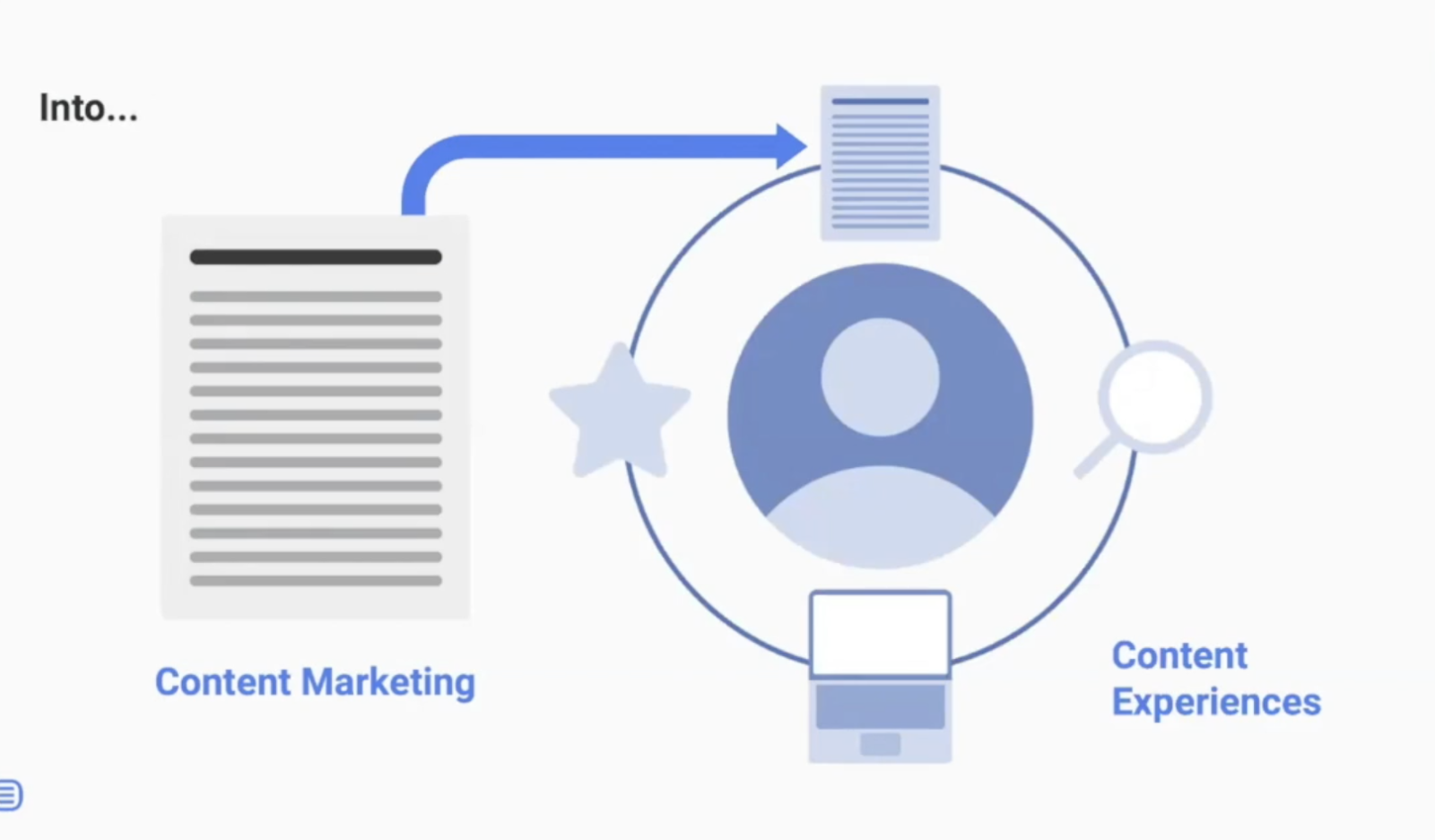
I'm going to show some very interesting examples.
Discovery & purchase
In the first phase, when we're talking about discovering a new product, researching how to sell that product and selecting a buyer you've got to start with content to attract; interactive infographics, ebooks, white papers, blog, and SEO. This is where you get started.
But when it comes to the research phase, you can go more about your product in demo videos, interactive brochures, you can create specific content based on what you do.
The selection phase is where the calculators come in. Calculators and solution finders are very powerful here, calculators to demonstrate the potential benefits of your product and solution finders are really helpful in cases where you have a broad portfolio of products.
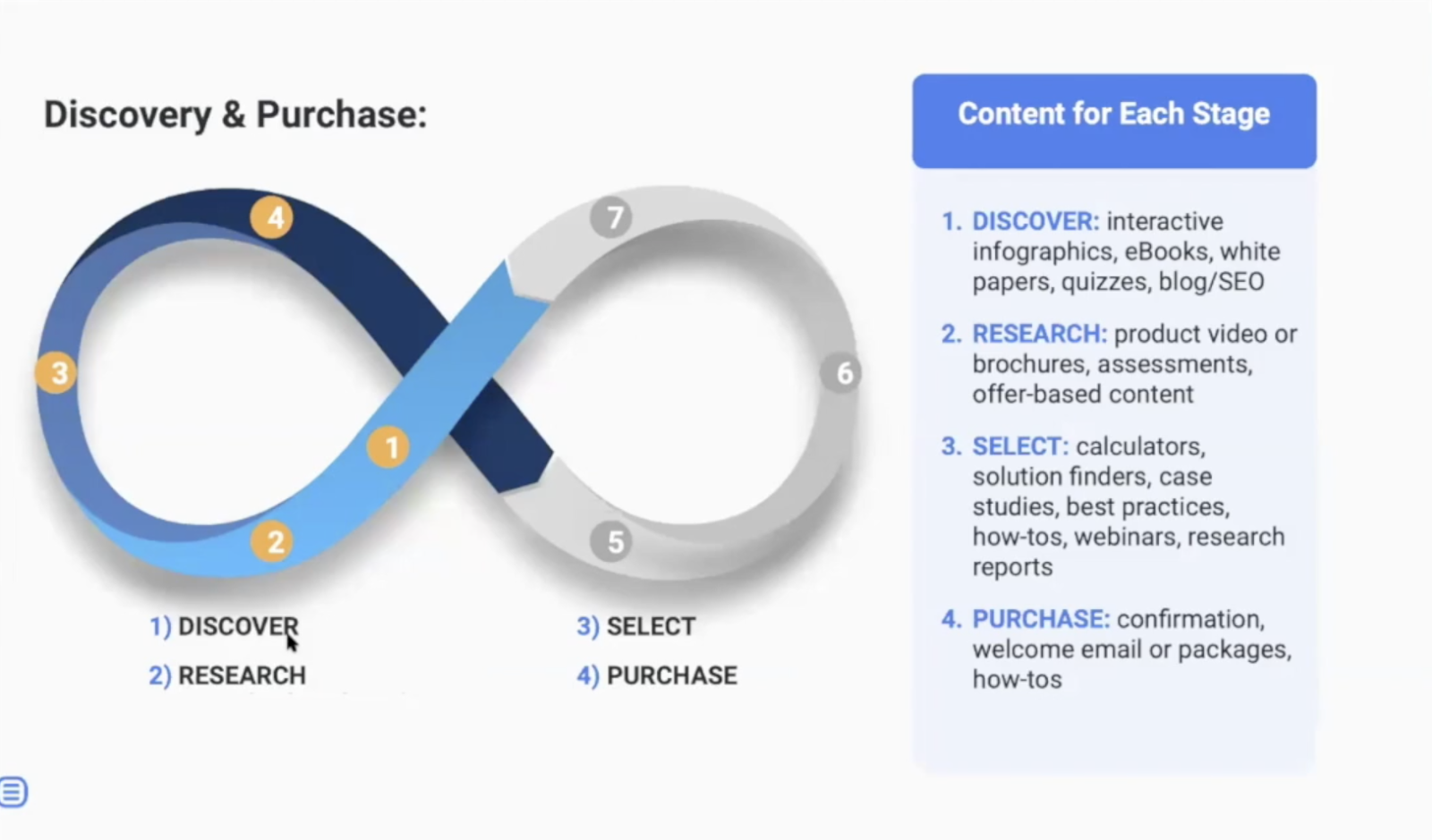
In the purchasing stage, there are several cases that are very interesting where you select, configure, and then buy in a very smooth journey.
Post-sale & relationship
When it comes to the post-sale and relationship phase, you can leverage it to help users adopt your solution. You can help guide them to functionality, you can help them learn about the topics you cover and you can help retain your customers.
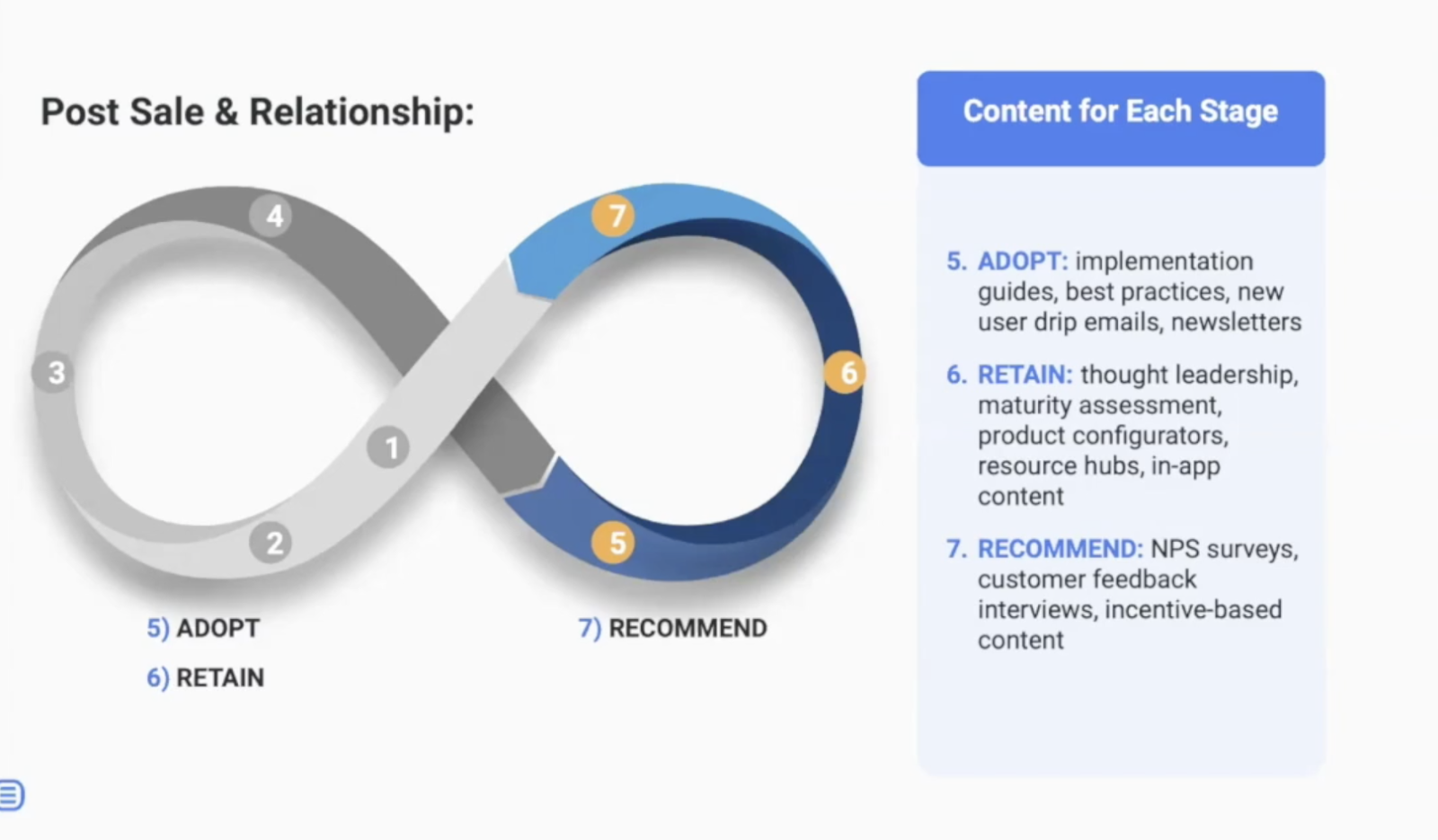
One of my favorite examples here is using maturity assessments and maturity models in order to see where your customers are, how they compare and personalize for that. Also on the referral phase where you can leverage these experiences to get referrals.
Early-stage of buyer journey
The goal: Engagement and awareness
Let's start with this early stage top of the funnel phase. This is where you want to grab attention.
What works
Typically your interactive experiences will appeal to a wide audience. Infographics or really strong quizzes, interactive white papers where you provide specific recommendations, lookbooks for your product catalog, etc, resource hubs.
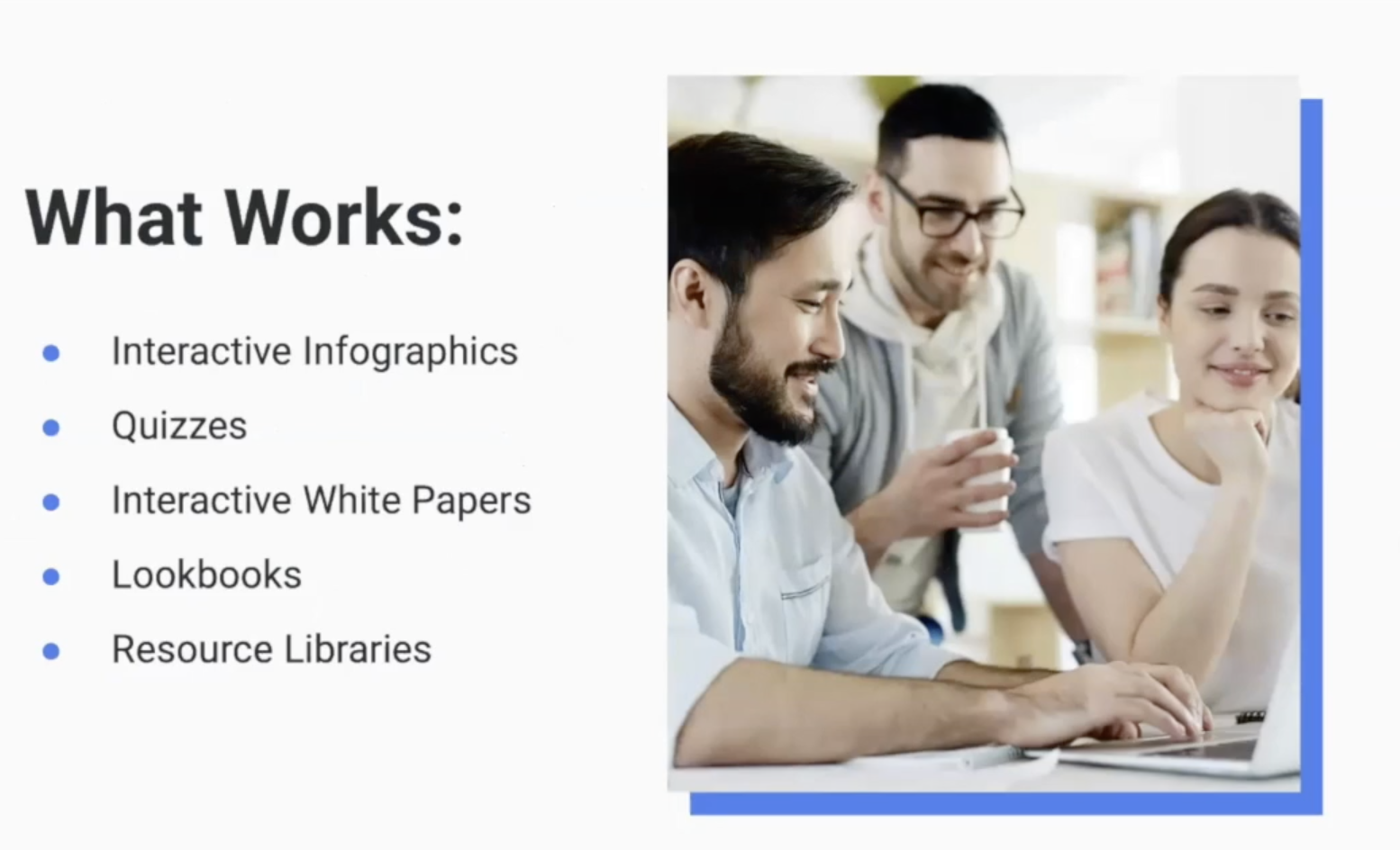
For those who are not aware a resource hub is a page in your website where you can list several different materials that you have and the customer can filter, sort and download the ones that matter more to them.
Here are a few examples from Pitney Bowes.
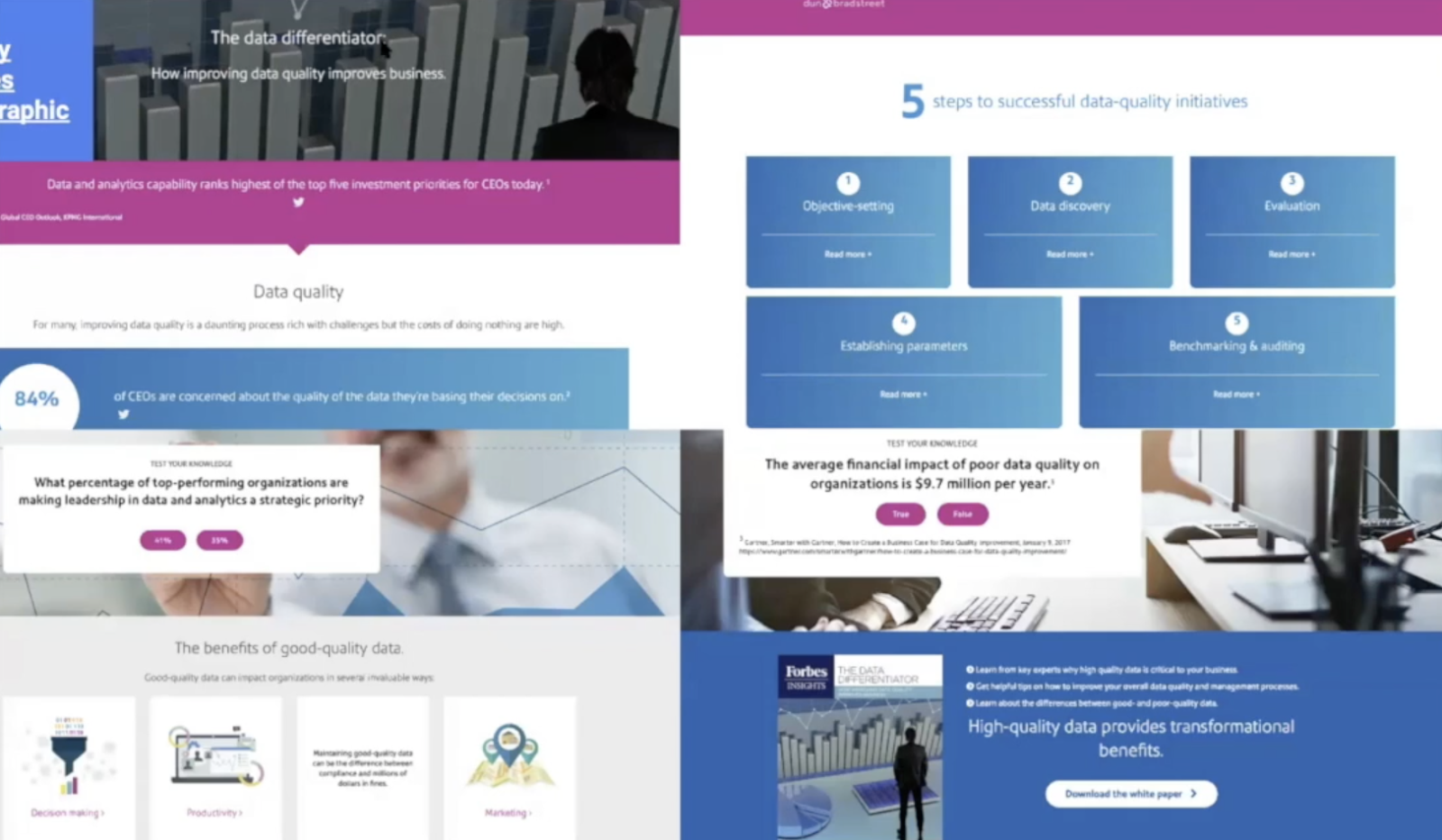
These are interactive infographics like the data differentiator, how improving data quality improves your business, five steps to build a successful data strategy.
These kinds of materials typically tend to drive the customer to test their knowledge, to see rich data based on a few interactions they do have, and also to download the white paper or an ebook afterward.
Mid journey
The goal: Education and exchange of information
In the middle of the journey, in the evaluation phase, the goal is education and collecting more data.
What works
Here what works is interactive ebooks, assessment, calculators, solution finders, product configurators.

Here is an example of an assessment from the same company, Pitney Bowes.
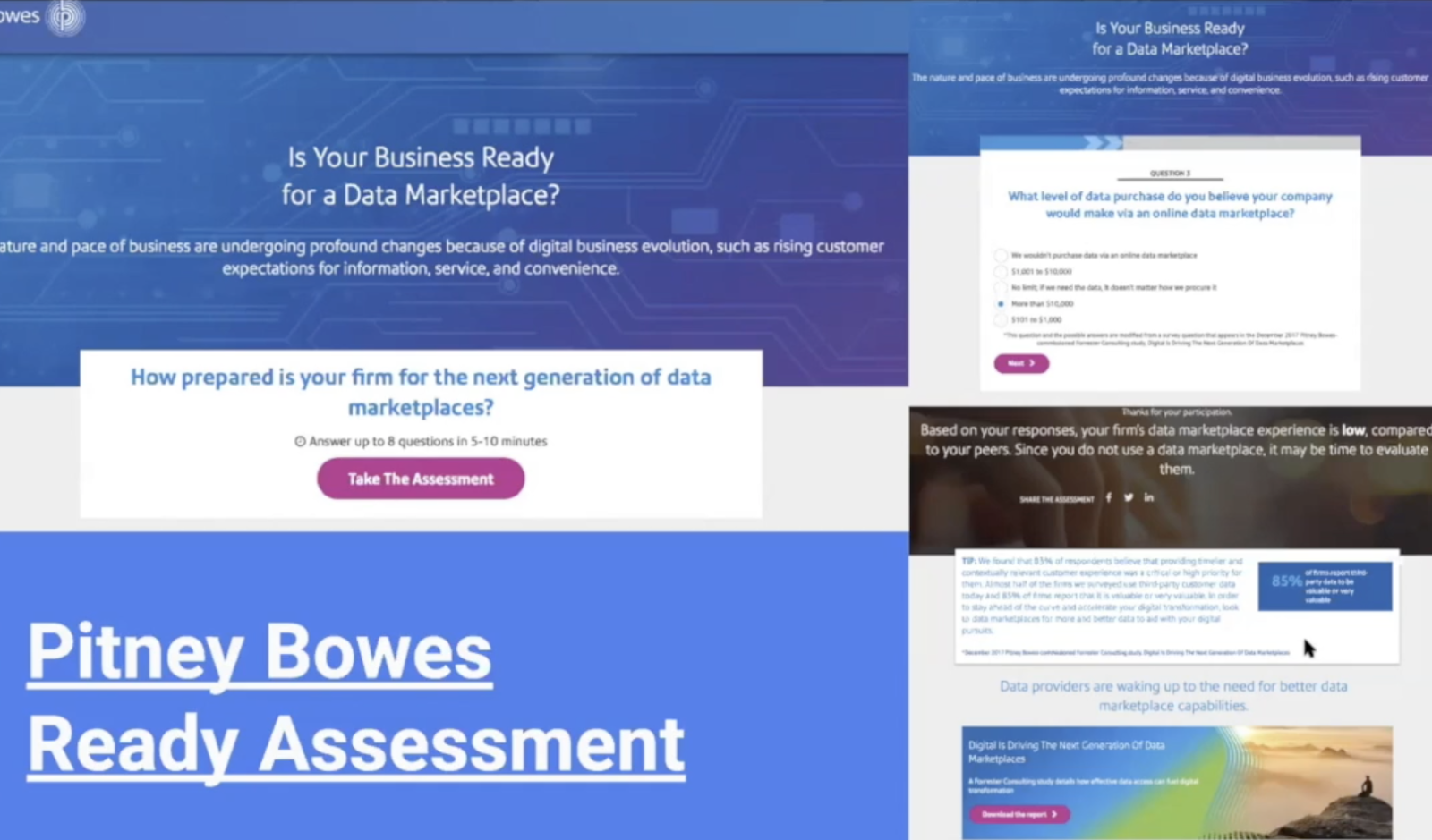
I love this because it addresses very closely the problem they solve. Based on eight questions, five to 10 minutes, you assess yourself, and you see how the company can help you. It's pretty interesting and I invite you to check it out - the link is here, feel free to play around.
Late stage
The goal: Ready to buy/act
In the later stages when the customers are ready to buy and to act, that's when you can go deeper and deeper in data collection.
What works
The most obvious tools here are ROI calculators, solution finders, product configurators.
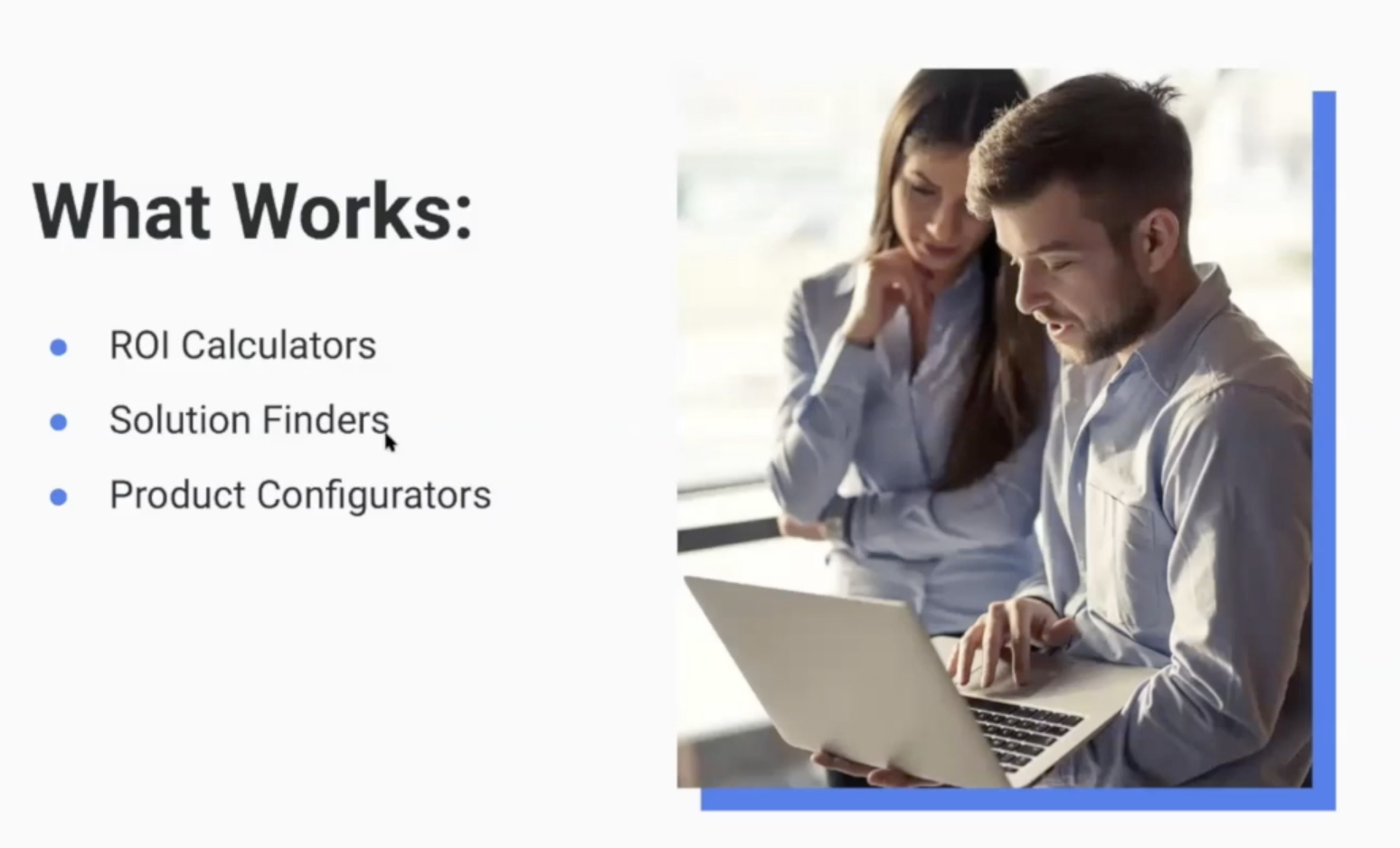
I'm going to dive deeper into ROI calculators at the end of the article as that's likely my favorite format.
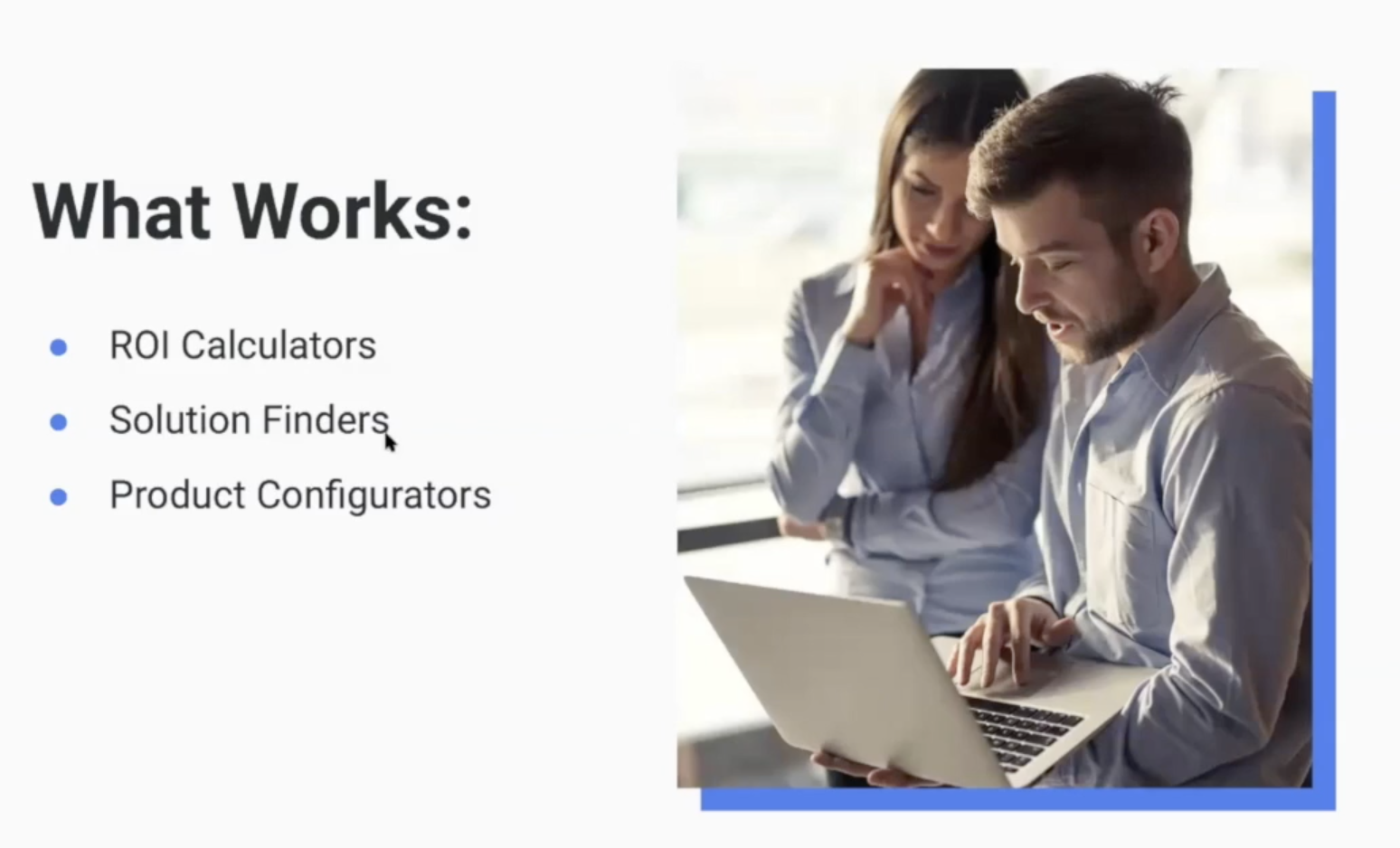
Solution finders
Imagine you are Oracle and you have hundreds of products. If you can collect data about your customers' pain points and challenges, you can ask a few questions and show exactly how you can help.
Product configurators
Let's say you have multiple plans and features and add ons in your SaaS solution, it's perfect to recommend the best plan or the best package for your business.
Here's one example of the bottom of the funnel by Precisely - for those who are not aware they have a software as a service platform for data, they have multiple data sets, and this data guide helps you understand by:
- What kinds of data.
- What kinds of data you can subscribe to.
- You can search by portfolio, region, or industry.
- Then you go into the secondary criteria to see which of their data sets is the best suited for you.
- Once you've found it, you can engage with a subscription and the questions help you go along the way.
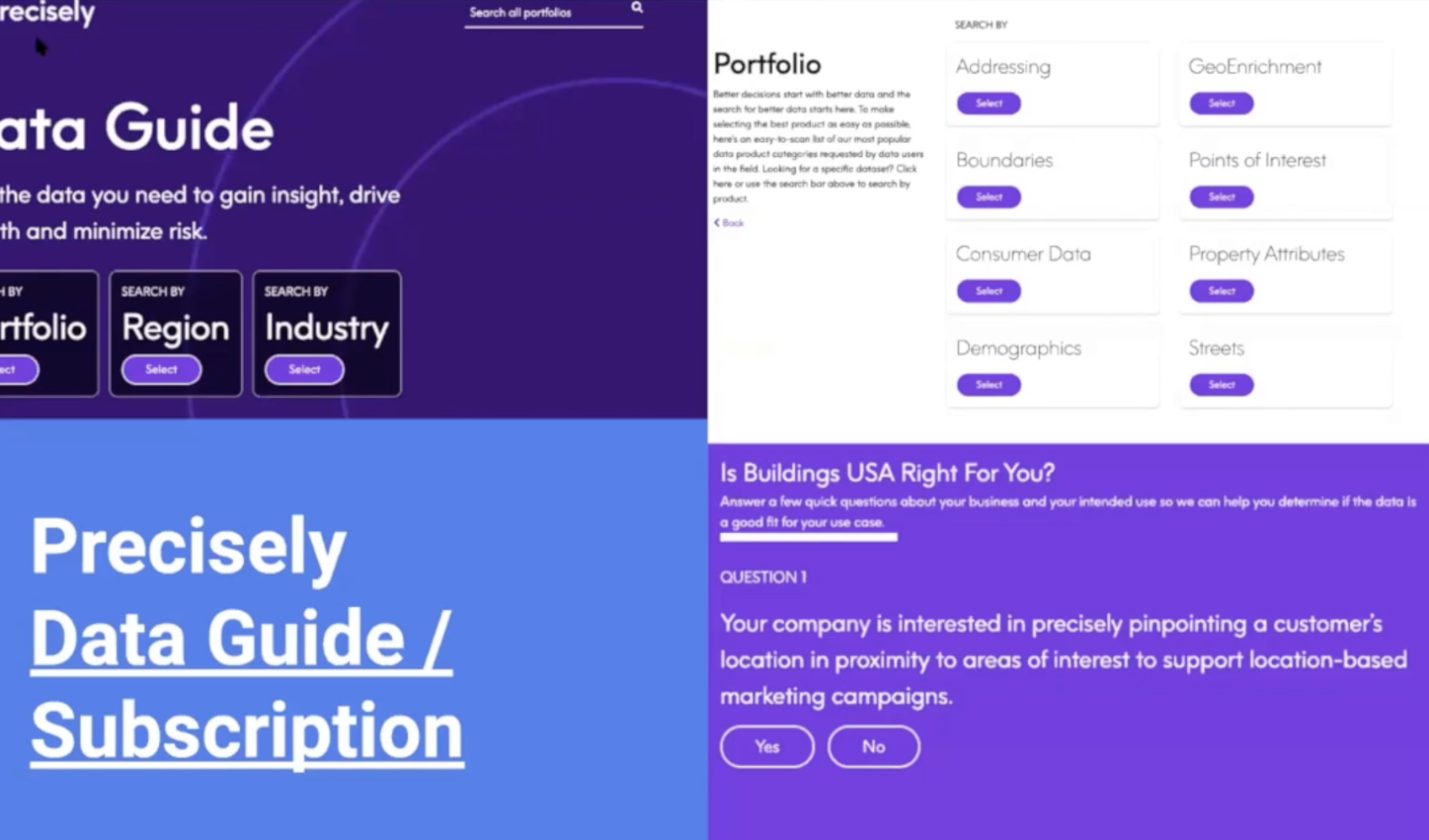
Five content experience best practices for SaaS businesses
Now we understand what interactive is and how it ties to the buyer journey, my goal is to bring five best practices that work very well for SaaS businesses with more examples.
Focus on utility
The first best practice for interactive is focusing on utility.
What to do
Is it useful?
What I mean by focusing on utility is to ask yourself, is this useful? Is this asking a specific question or addressing a recurring question from my audience?
Create what educates
Create educational materials, and with these educational materials, the user has to want to share them.
Prioritize
Always ask what's in it for my customer, what are they getting out of this?
If you deliver that value, you will get visibility and make an impact on their buyer journey.
Give it freely
Give it free and very often ungated, make it open and at the end of the experience, consider asking for identifiable information.
What not to do
Let your agenda drive the experience
Don’t focus on you and what matters for you only or for your business. You have to
put yourself in the customers’ shoes, you have to explore their doubts. Do not focus on your goals.
Make the customer work too hard
Don't make it too hard to get value. Very big forms and lots of questions in interactions typically do not work.
Force form completion
Do not force form completion for all content. Do not try to gather all the information you need especially in the early stages of the journey.
Interactive for the sake of it
Don't make it interactive just because it's fun or beautiful. I think it has to be beautiful. It has to be fun. But the main and the most important thing is being useful.
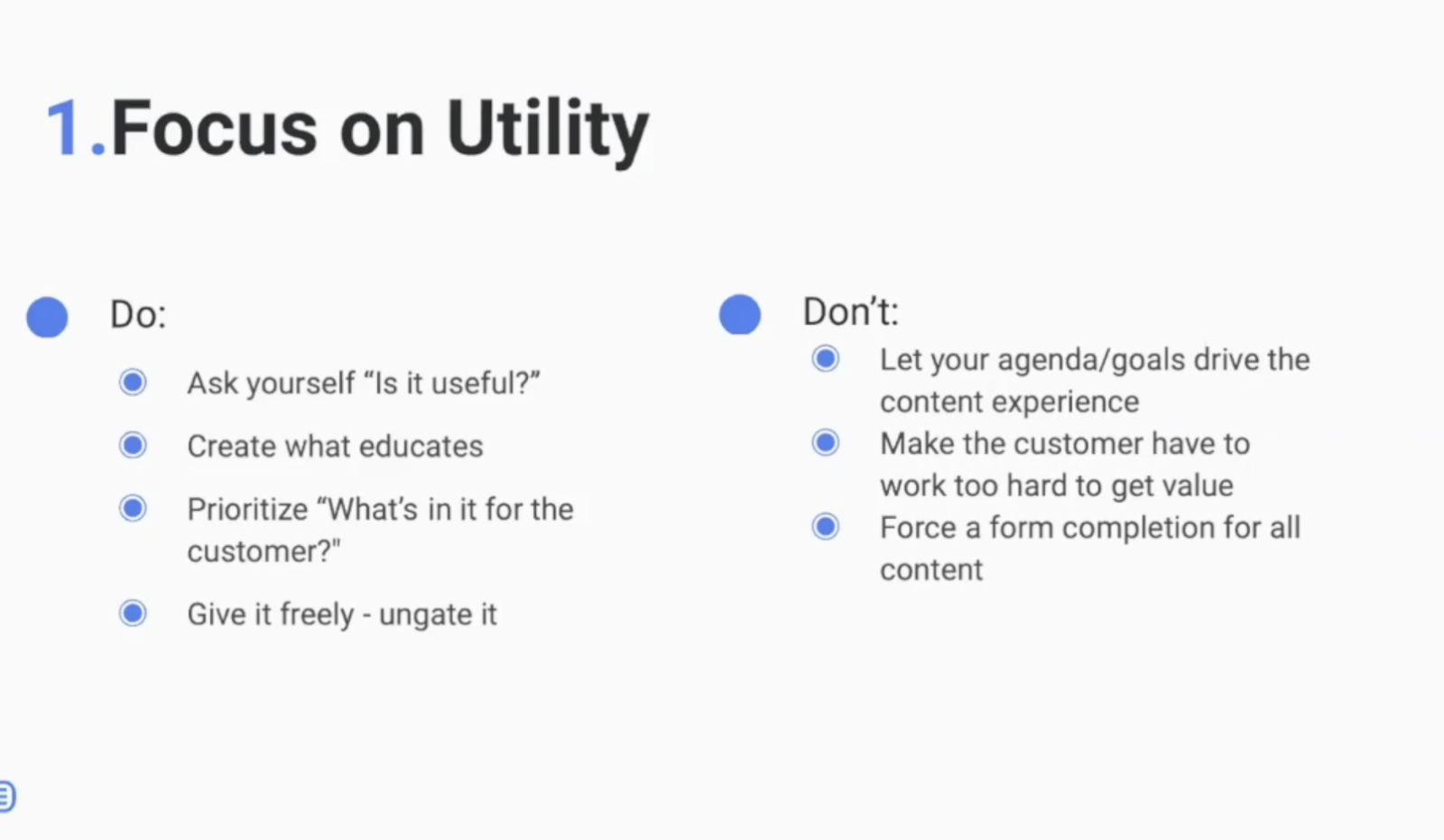
Here's a great example of what I think is useful and also super valuable. This is the CompTIA Technology buyers journey, it helps you clearly understand in a very simple experience, how the buyer’s journey works.
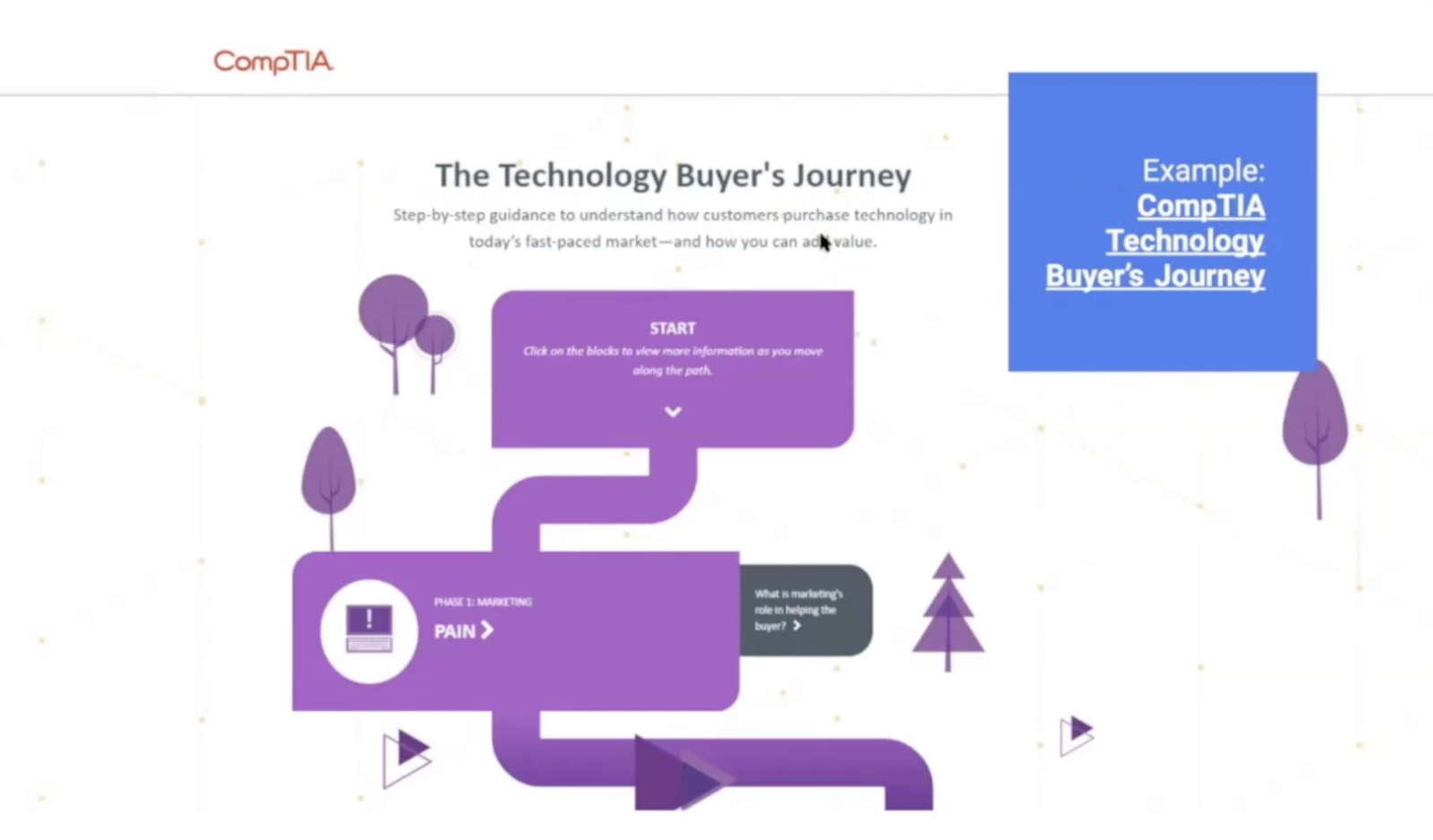
It's an interactive experience about exactly what I'm saying here.
Continuity and consistency
The second thing that is really important is continuity and consistency.
What to do
Stay focused
The first thing here is you have to stay focused on helping the customer achieve their goals and you have to be constantly mapping that to what's the next logical step for the customer?
If you only leverage an interactive experience on the top of your funnel and you don't go down, you lose this familiarity and these great conversions the format brings.
Remain present
You have to be present there and keep adding new value to these new formats and new experiences you can bring.
I would suggest if you are committing to interactive pick three to four experiences that you think your funnel needs and create those, let's say one a month or one a quarter.
Give equal weight to post-sale experiences
Give equal weight to not only the pre-buy-in but also post-buy-in. I think the best example here I like to bring is to assess your customers’ post-sales, see how they are evolving, I'm a big fan of maturity models.
So the moment that guy buys, how mature is he in the area you add value? How would that look 6/12 months after?
Keep engaging, keep gathering data, and leverage this data to drive even richer experiences.
What not to do
Overburden support and success
Do not put all the weight of distributing these and interacting with your customers only on support and CS. Leverage marketing automation, leverage customer nurturing through email, be creative.
Stop creating content
Never stop creating these experiences and these rich marketing assets after the guy becomes a customer.
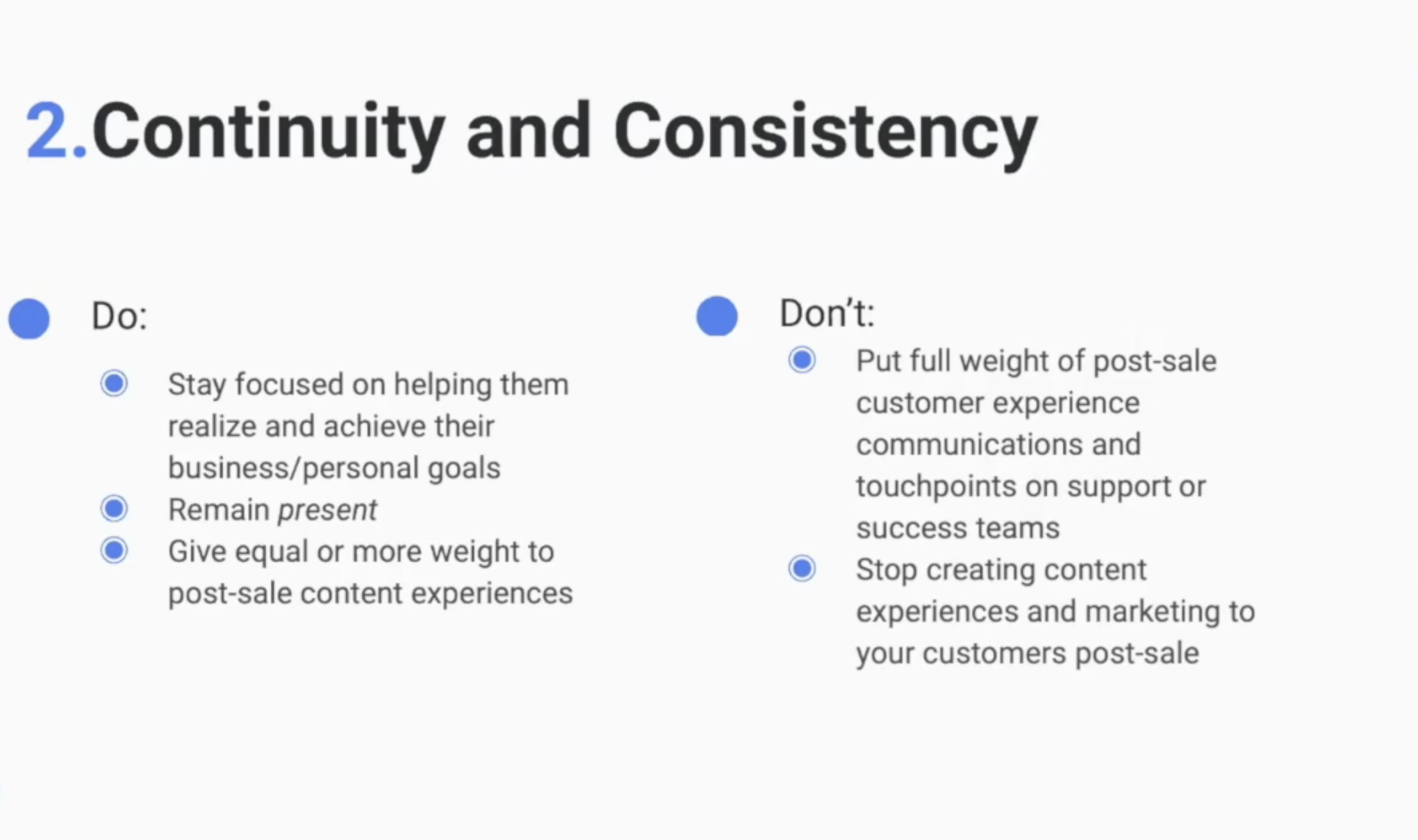
Turn data into experiences
One of my favorite things about interactive it's that it's data first.
What to do
Map sales questions
You can map your sales peoples' questions to interactive experience fields and questions. A very rich source to automate and create great experiences is if you have a sales team, go there, listen to a few calls, map the main questions they and the customers have, and use that.
Leverage data
Leverage the data the customer gives you to provide real-time smart recommendations. Let's say you ask on a form how many sales reps do you have and how much each is selling, a great next step would be "Okay you have x sales reps and their selling on average z - this is how you compare to companies with the same number, this is how you compare two companies in your industry".
This is what makes amazing interactive content and also this is what helps you create unique paths for each customer.
Create unique paths
If you gather data that is valuable to generate advice, collect the data and use that to make sure as much as possible every single customer gets their own unique experience with your assessment and with your ROI calculator. This is super valuable.
What not to do
Forget to integrate
The first thing is never to forget to integrate it with your marketing technology stack, with your marketing automation platform, and set up smart notifications. Because if you have a data-rich experience, let's say your company sells CRM, and you sell by seat, if on your industry assessment you discover one specific company has 1000 sales reps, you better alert your sales reps and your team that this is a real high value lead.
It has to be integrated into your CRM and your marketing automation platform.
Keep data for marketing team
Also, never let this data live only for the marketing team, you have to pass it along to sales, to CS, to support. This really helps you ensure everyone is aware of every interaction your customers have.
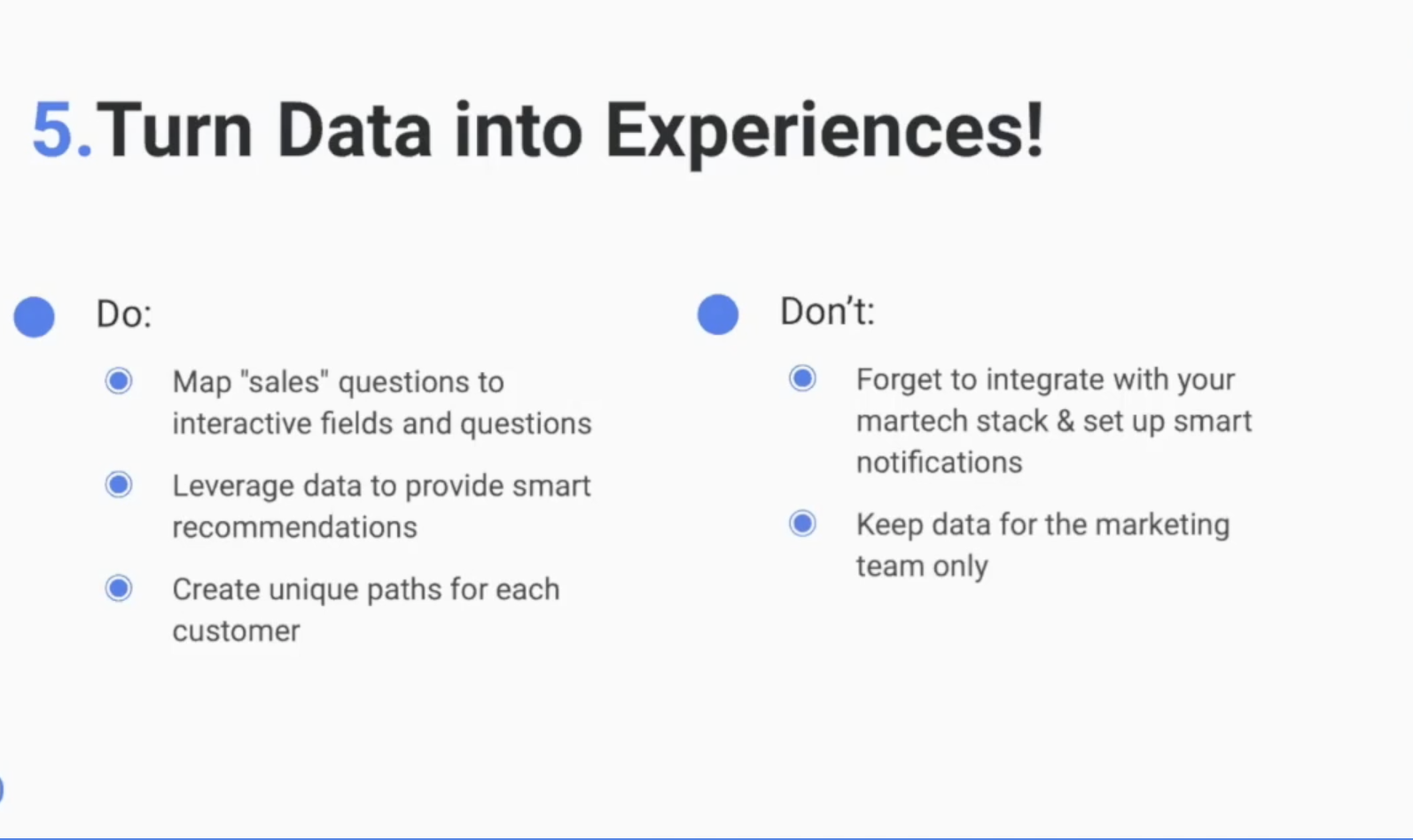
Data-driven content
Data-driven content aims at capturing information through natural engagement. I wouldn't say that a form field is a data-driven content - reach assessment or reach ROI calculator is a data-driven content piece. Because once you get that data, you can deliver the right content at the right time and you can create really unique content for each customer.
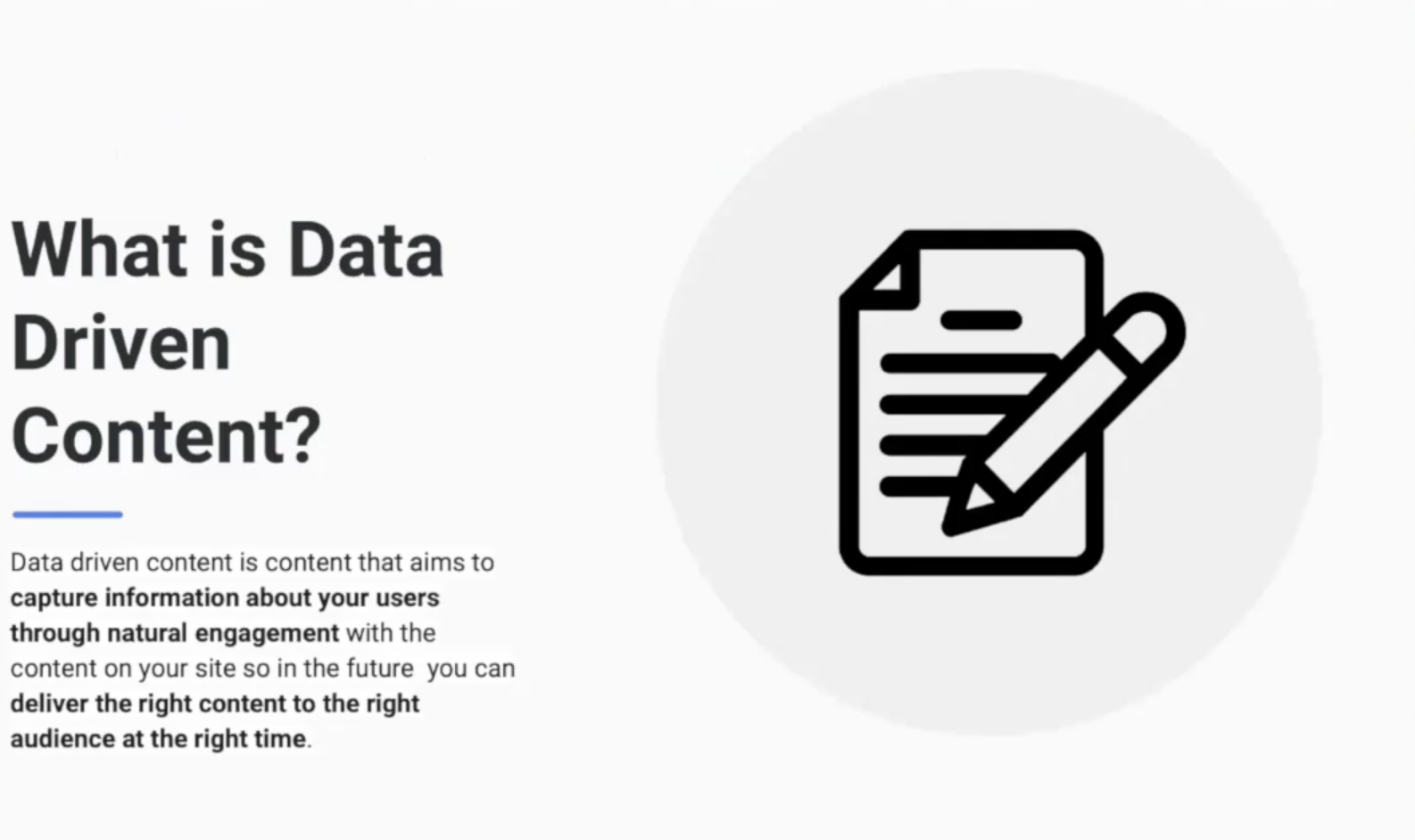
I think one of the most relevant things about interactive is today we are all aware of the new privacy laws, GDPR, CCPA, LGBD, and these new legislations are very strict on privacy, which I think is great.
But it makes it harder for you to get data because I'm not sure if everyone is aware but there are three types of data.
- First-party data, data that you collect.
- Second-party data, data you buy.
- Third-party is data aggregated from various sources on a high scale but less and less efficient these days with the new regulations and the new functionality adopted by the browsers.
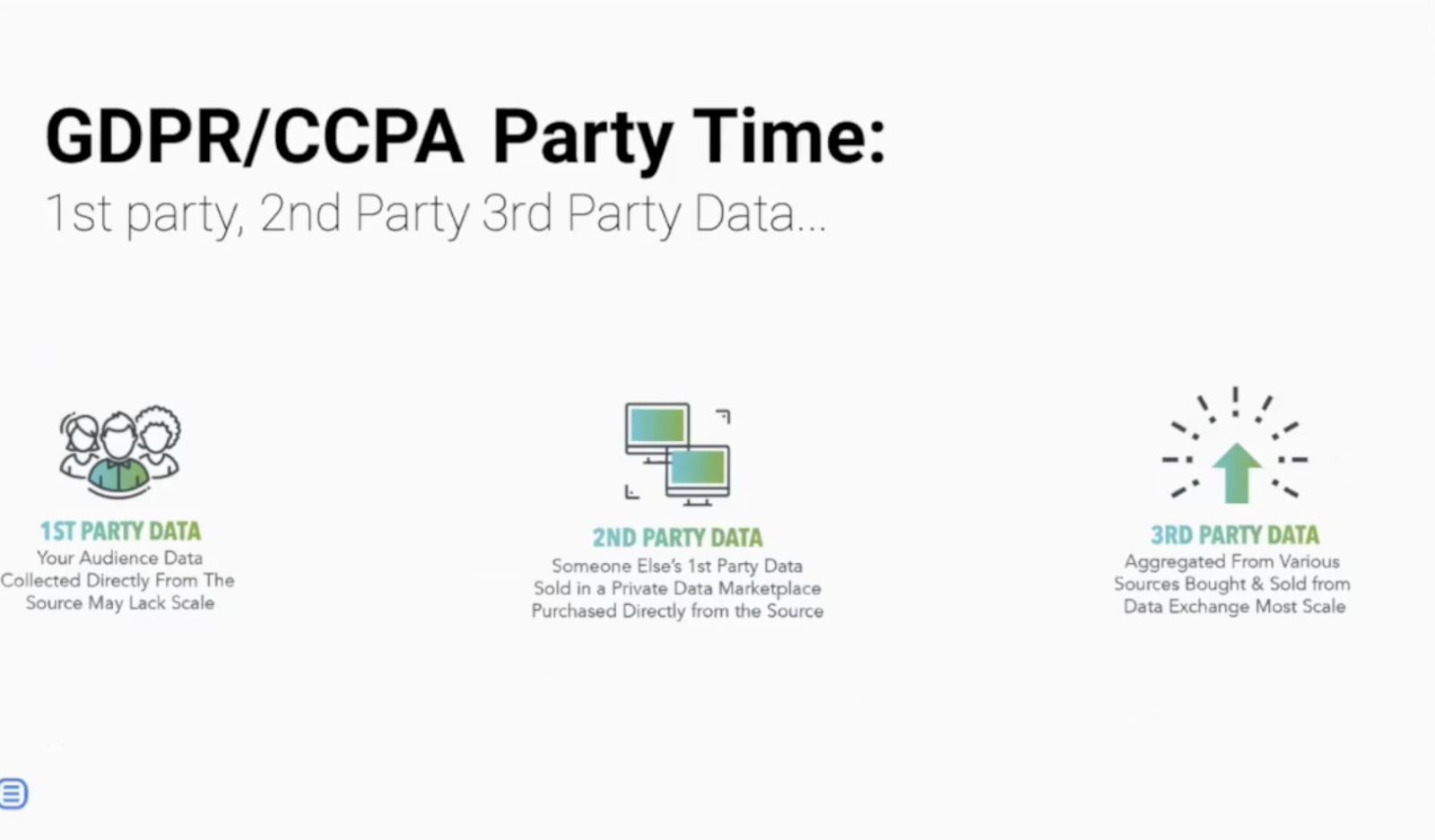
Interactive content is first-party data, it's the highest quality type of data because the user engages and shares that data solely with you.
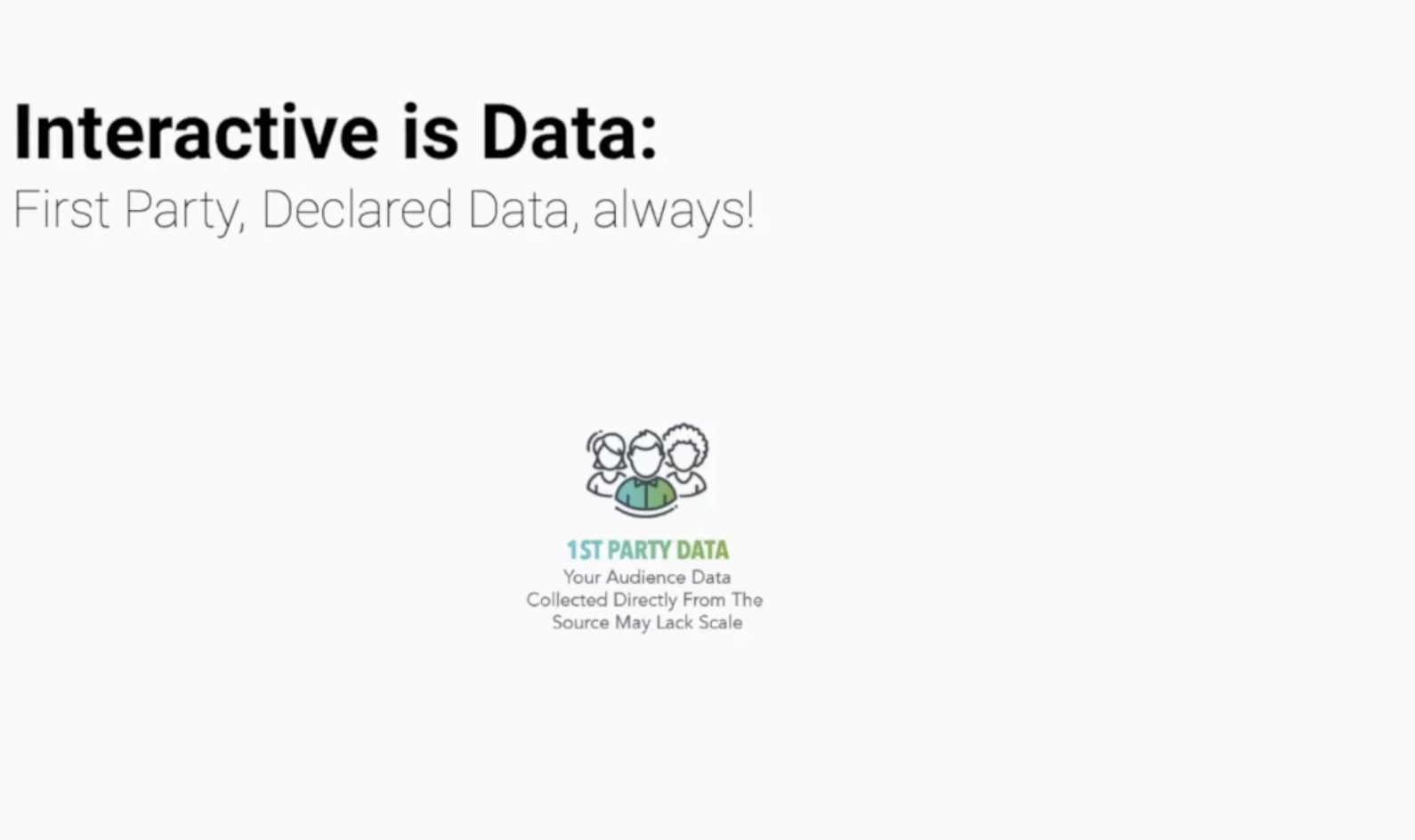
So be relevant, be mindful of what you're asking, take a privacy commitment from your company. But interactive is amazing for data. I want to highlight one example here which I think is pretty cool - the Autodesk Resource hub.
- They start by asking you your name and your function - are you a designer? Are you a 3D animator? Then they personalize their content to you.
- Immediately after that, what's your skill level? I'm new to this. I'm advanced. I'm a power user.
- Based on that, you see personalized recommendations and this data is going through their marketing automation system.
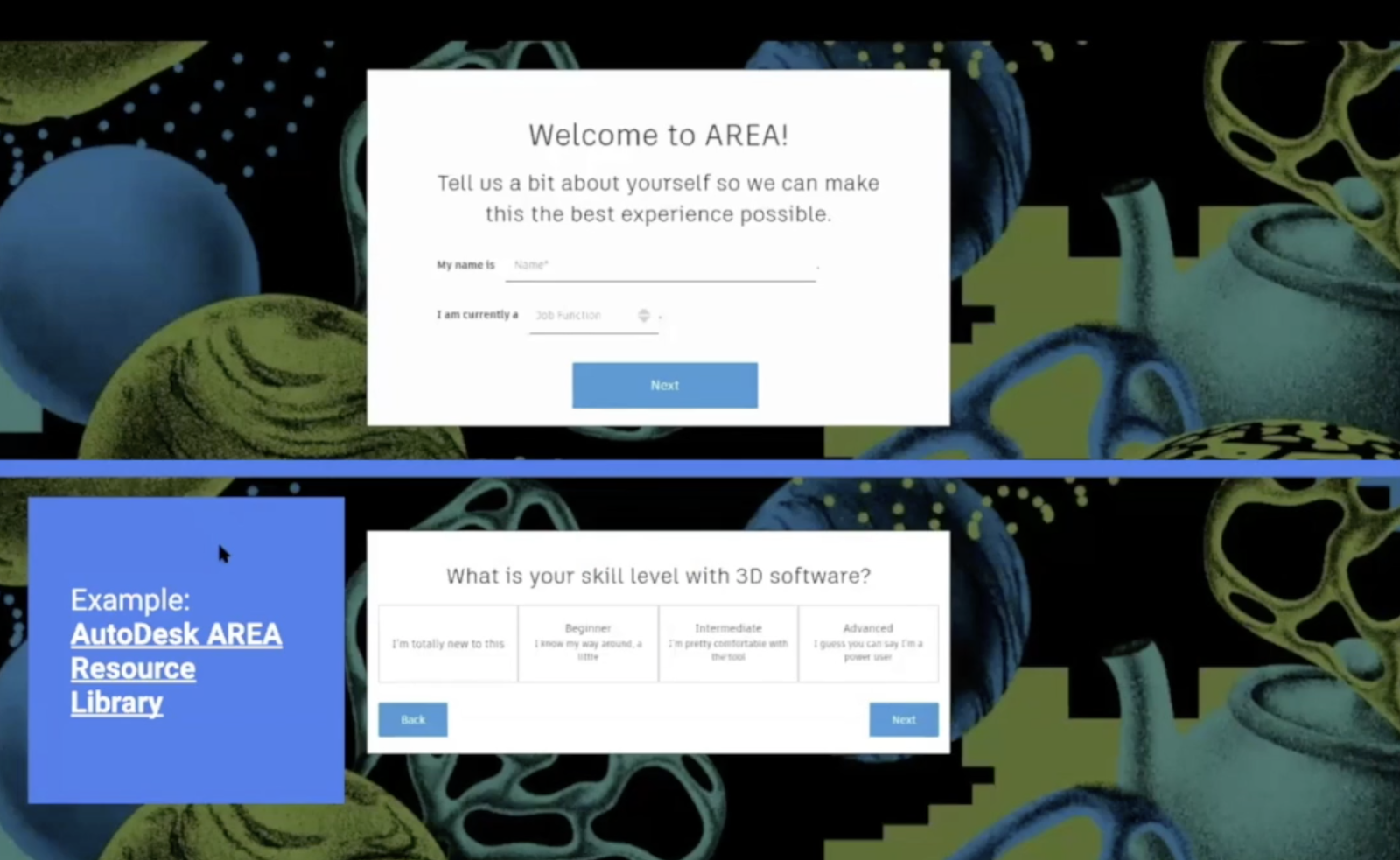
So I know if I'm a sales rep, and I'm gonna call this guy, "Oh, John, I noticed you were a designer at company x and you're a 3D software power user, I think we can help you". That's the kind of personalization brought to the table and that's how you can leverage data in very powerful ways.
4. Make sales reps lives easier
How do you achieve this?
What to do
Aim for an interactive component
First, aim for the interactive component to drive participation and engagement. Think of it as a conversation.
Consider the data and learnings
Consider and listen to the calls - the sales team is the best source of ideas for indirect experiences.
Put the data to work
Then you put that data to work either by notifying sales reps or delivering real-time recommendations to your customers. They will love this.
Be useful and helpful
Always, like any sales tactic, you have to be useful and helpful.
What not to do
Overcomplicate it
Don't complicate it. Make it simple. You don't need to ask all those questions. Pick the ones that can help you drive more value to the customer and to your sales reps.
Create content you can’t measure
Do not create content that you can't measure. For each experience, have a definition of success. If I'm a CRM company, I want to find companies with these profiles, and success for me means finding these niches out of all my respondents.
Stray from simple helpfulness
Not just being simply helpful, be more sophisticated, you can do some really interesting things and I'm going to show you a few examples.
Collect and personalize
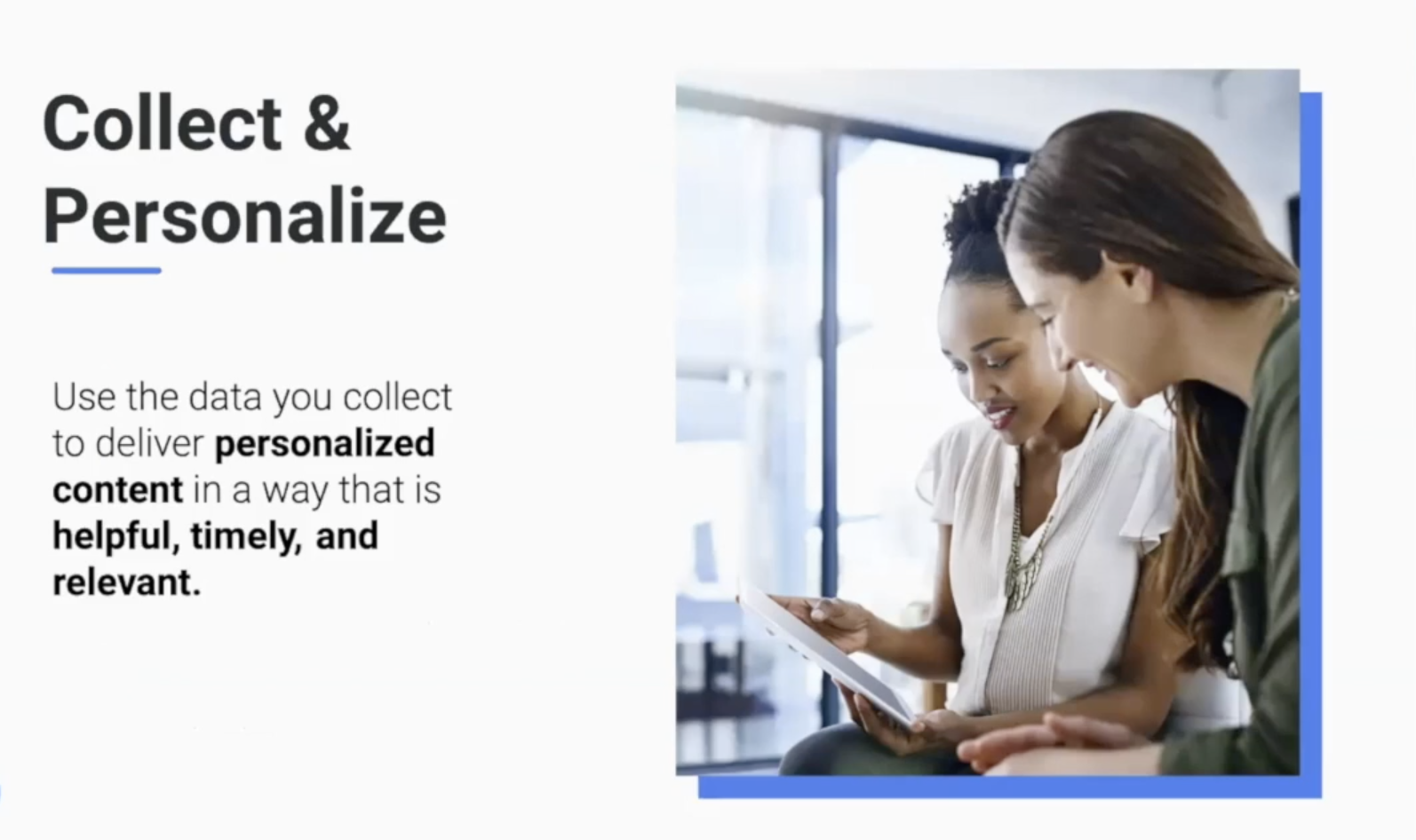
Every data point you collect is a personalization opportunity. When you personalize, customers get excited, you're going to be less repetitive in the sales process.
Personalization must be impactful
A few examples here. When I say personalization I'm not saying "Hello, [first name] from [company x]". That's boring. That's a commodity.
I'm not saying you shouldn't do it. But I'm saying, "Diego, I notice you have five sales reps, or 50 sales reps, and you have this average performance per sales rep. This is how much we believe we could help you improve your customer acquisitions by".
Why do salespeople love interactive content?
Save the rep time during discovery
The first thing is saving time from the discovery call. Imagine if your key qualification criteria at your company are the role, the seniority of the prospect, how many potential users they have, what their company revenue is - you can collect the vast majority of this information through interaction.
This makes sales reps more productive, more relevant, customers do not have to repeat themselves. They simply love it.
Buyers become more educated
Another key benefit is the buyer comes in educated. If I use the example from the data guide at Pitney Bowes 0- these are the data sets I have, the customer already saw that, when he comes to talk to the rep, he says, "I noticed you have this, this, and this data set. This and these are fit for me, I have a few doubts, let's go through that."
Reps love that because it evolves the customer to a journey in a very smooth way.
Surface SQLs easier
You can easily surface your best sales leads. Rather than just relying on the only form fields, when people get more in return for the data they are providing, they are willing to open more and go deeper into what they share with your brand.
One example is if you have an assessment, and you are collecting data about sales performance, if you ask a prospect about their industry and revenues, so they can compare themselves to their peers, they will very likely provide you that information because everybody loves benchmarking.
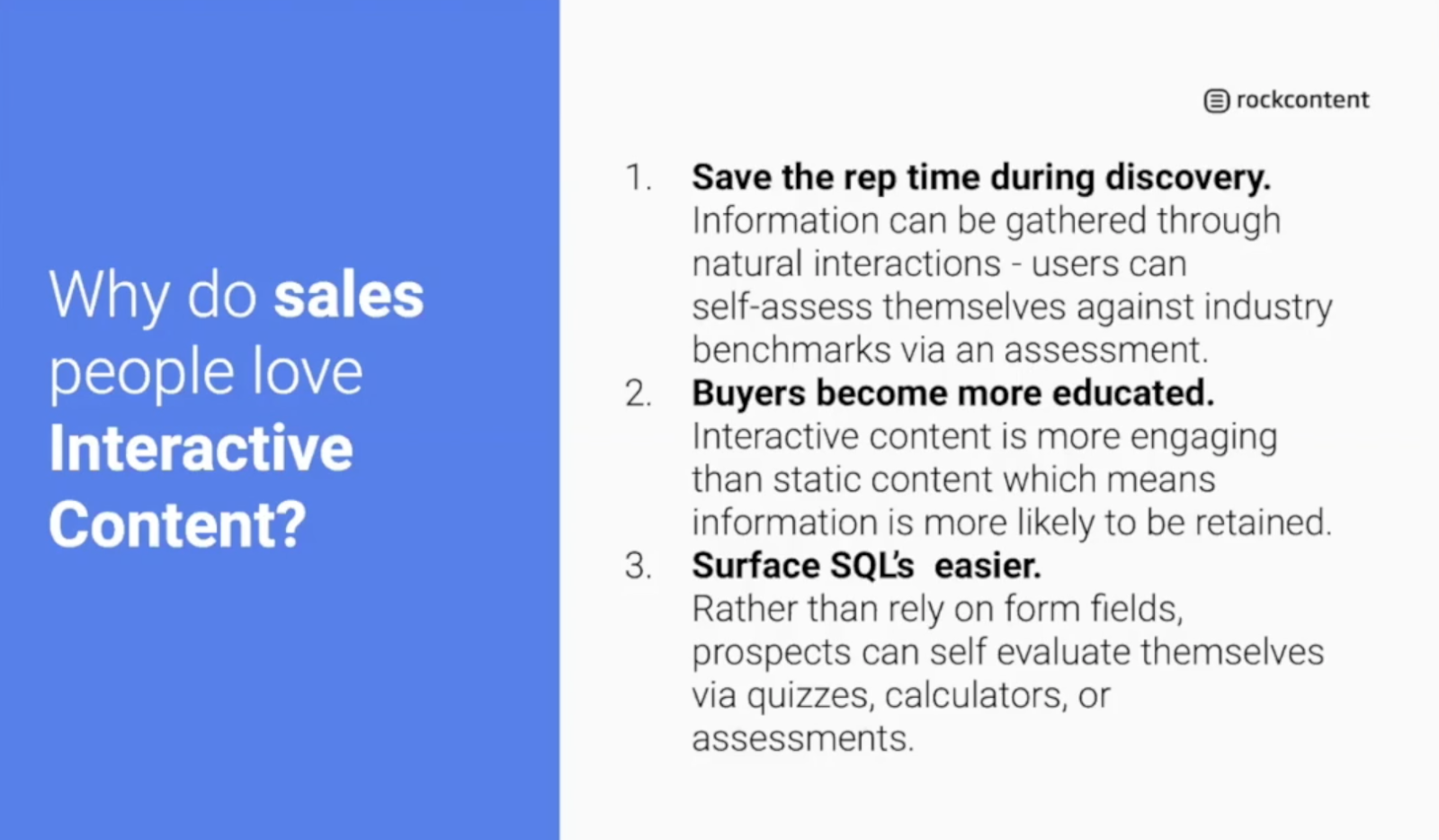
Demandbase tech stack evaluator
A very cool example I want to share with you is the Demandbase tech stack evaluator.
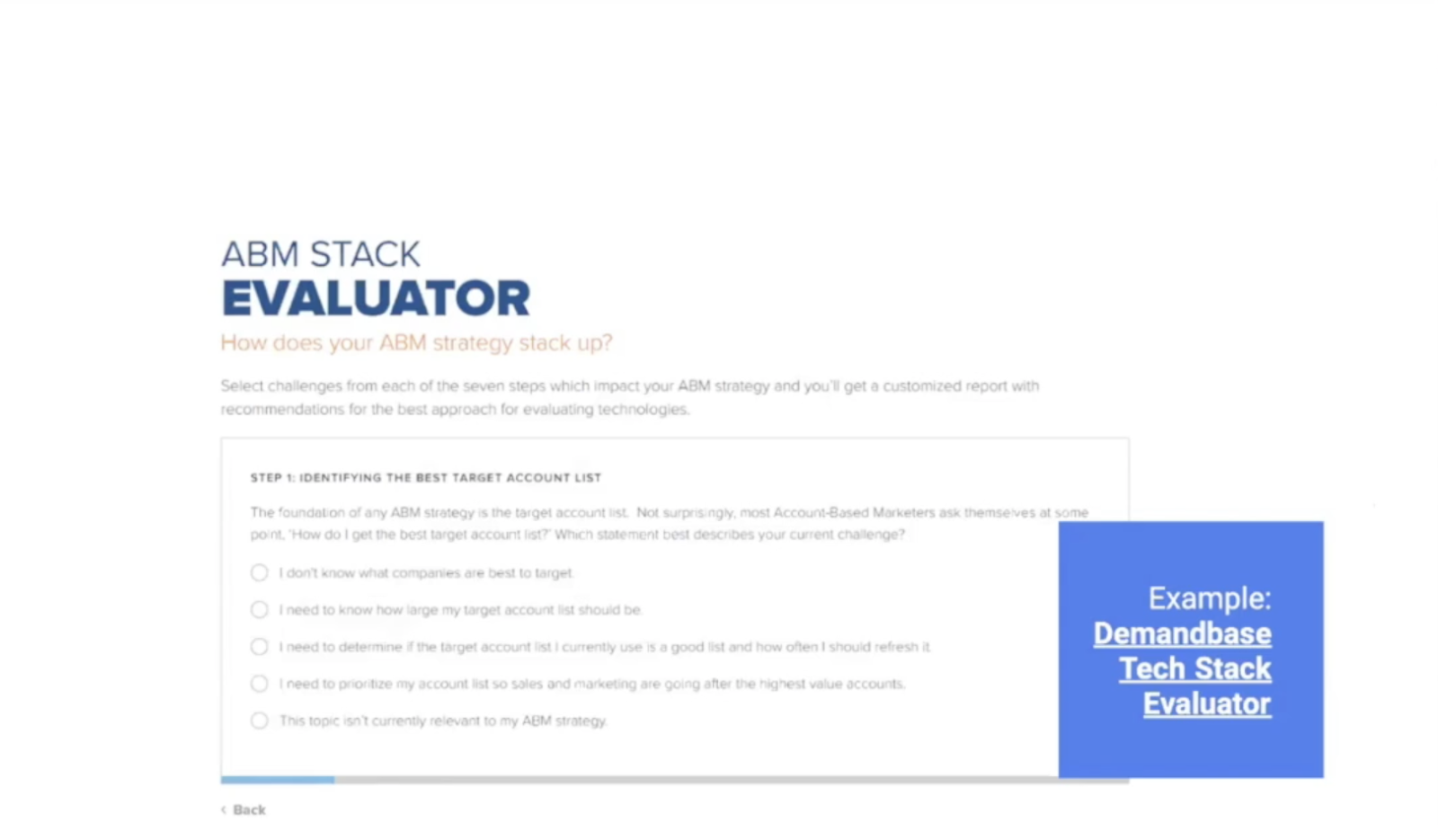
The idea here is to help customers select their ABM stack and they're going to have to answer a few questions like which statement best describes your current challenge?
- I don't know what companies are best to target.
- I need to know how large my target account list should be, etc.
There are several challenges but when you play with it and you provide value to the tool, the tool adds more value to you.
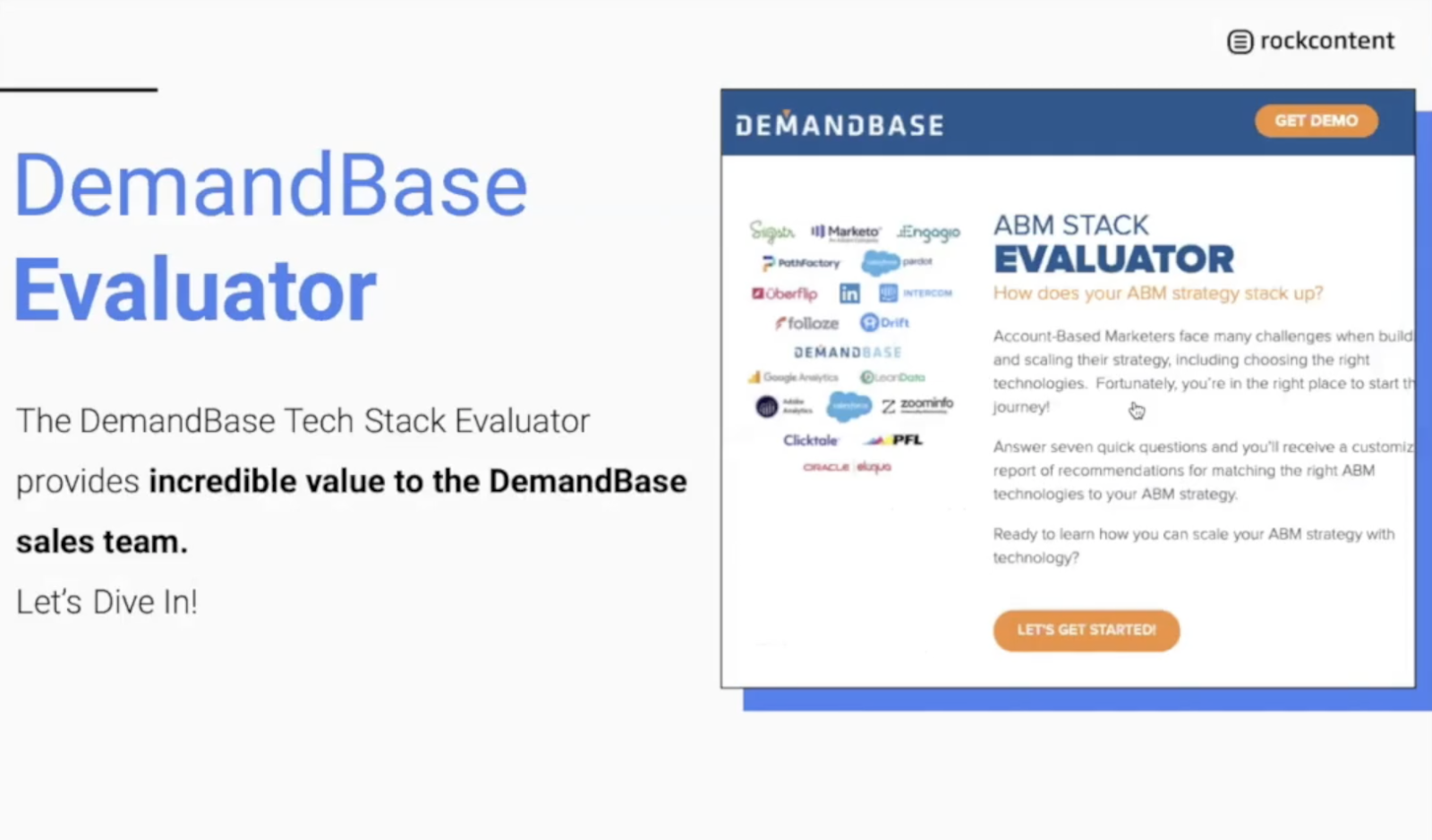
Here's an example question. 'I need to know how large my target accounts list should be'.
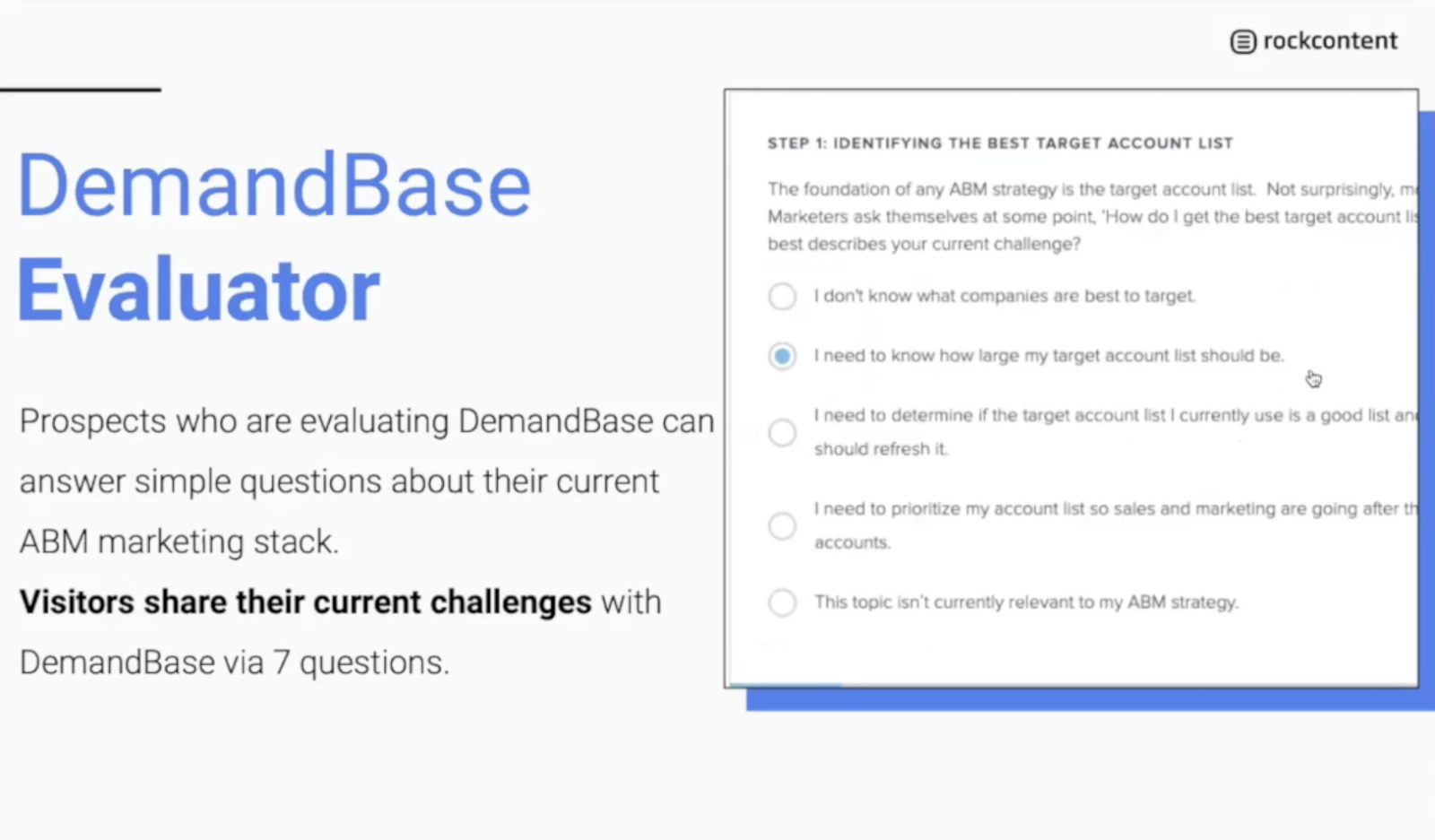
As you go through each of these questions, here's what you get.
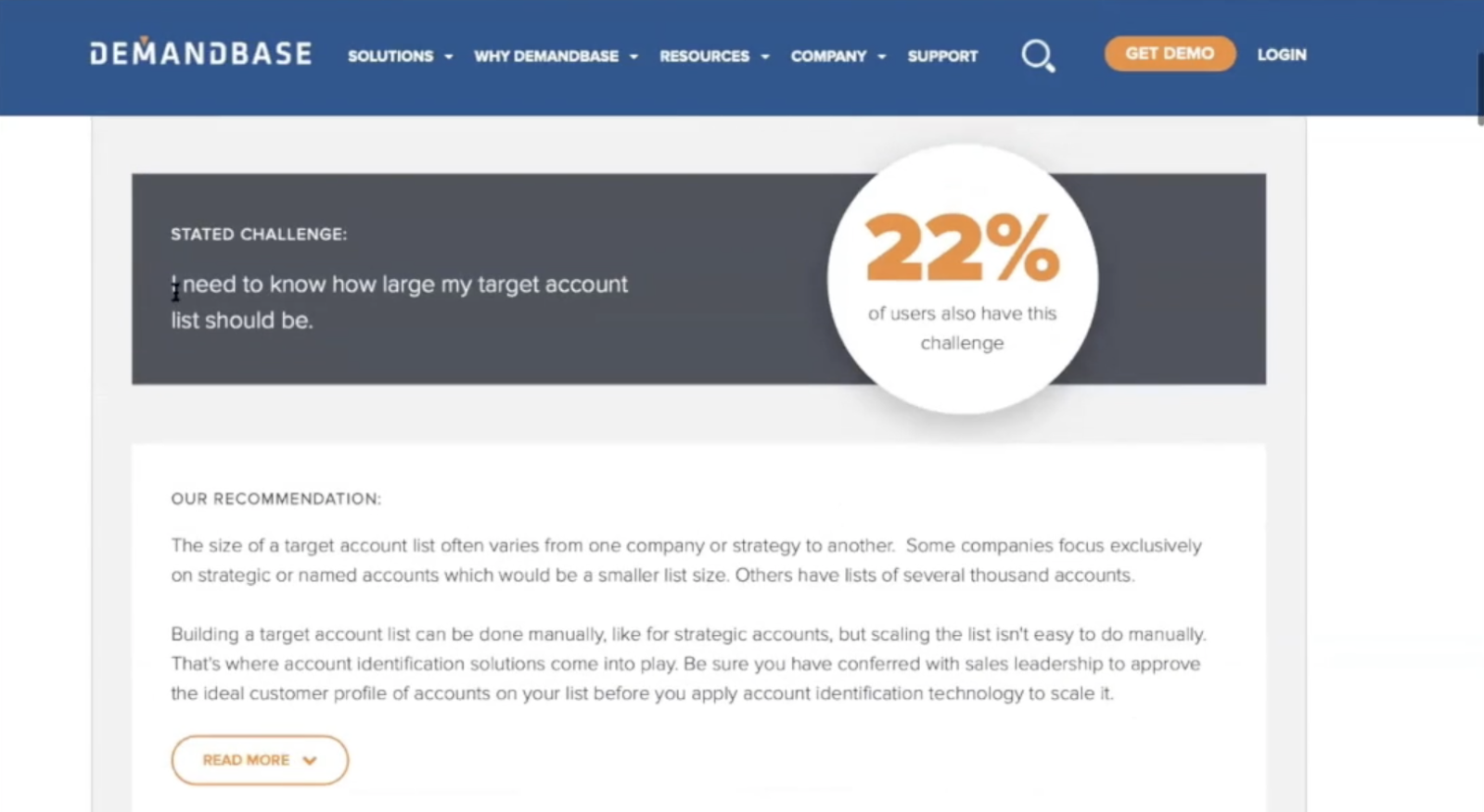
22% of the other participants also have the same challenges, this is the recommendation for that.
When it comes to targeting accounts, and this is my challenge, there are the recommendations, the solutions they recommend and it's the same for each of those questions.
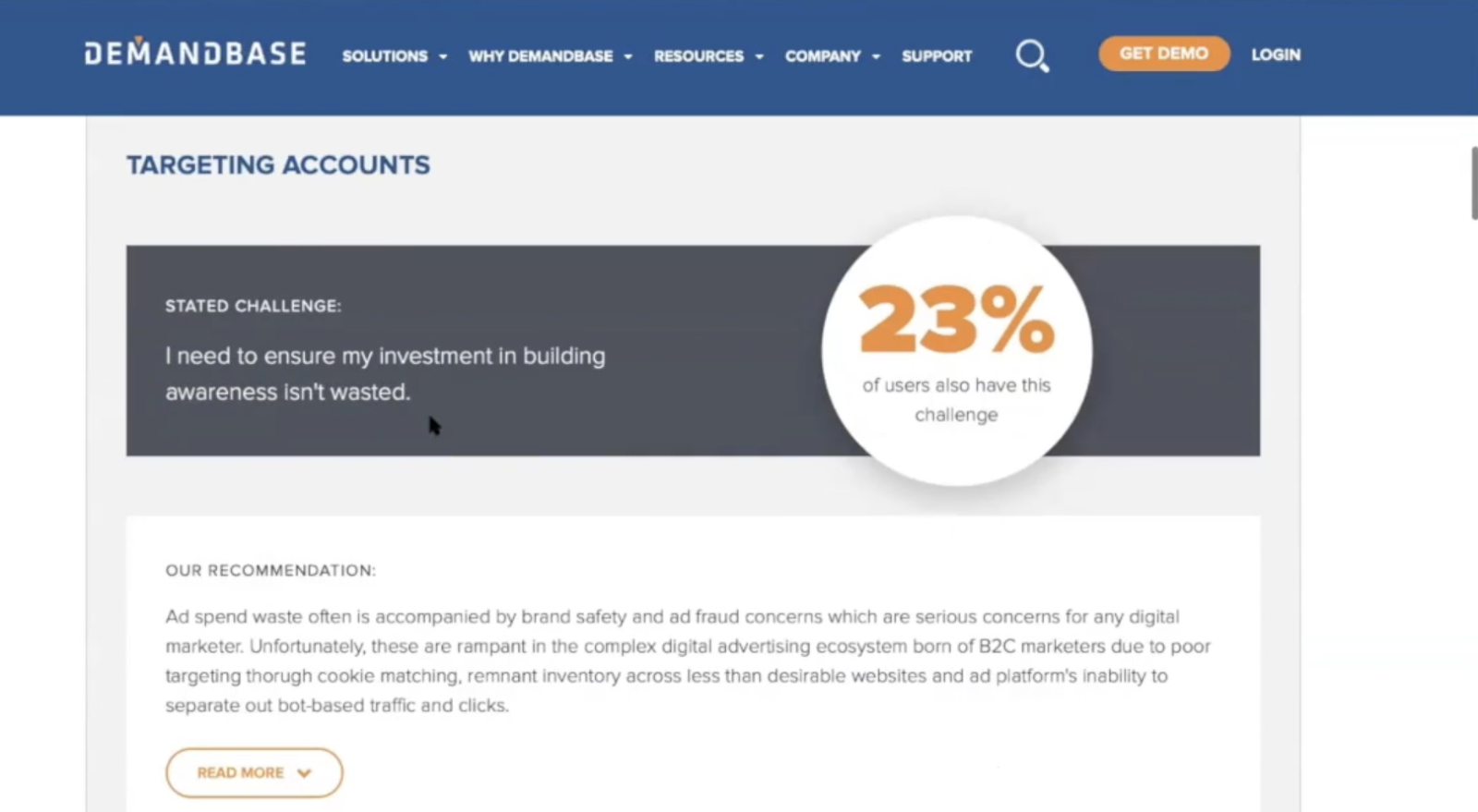
It's a super valuable piece. Salespeople love these kinds of interactions because they can see what's going on and how they can personalize the communication with the prospect.
One thing that I really like is this description by Scott Brinker.
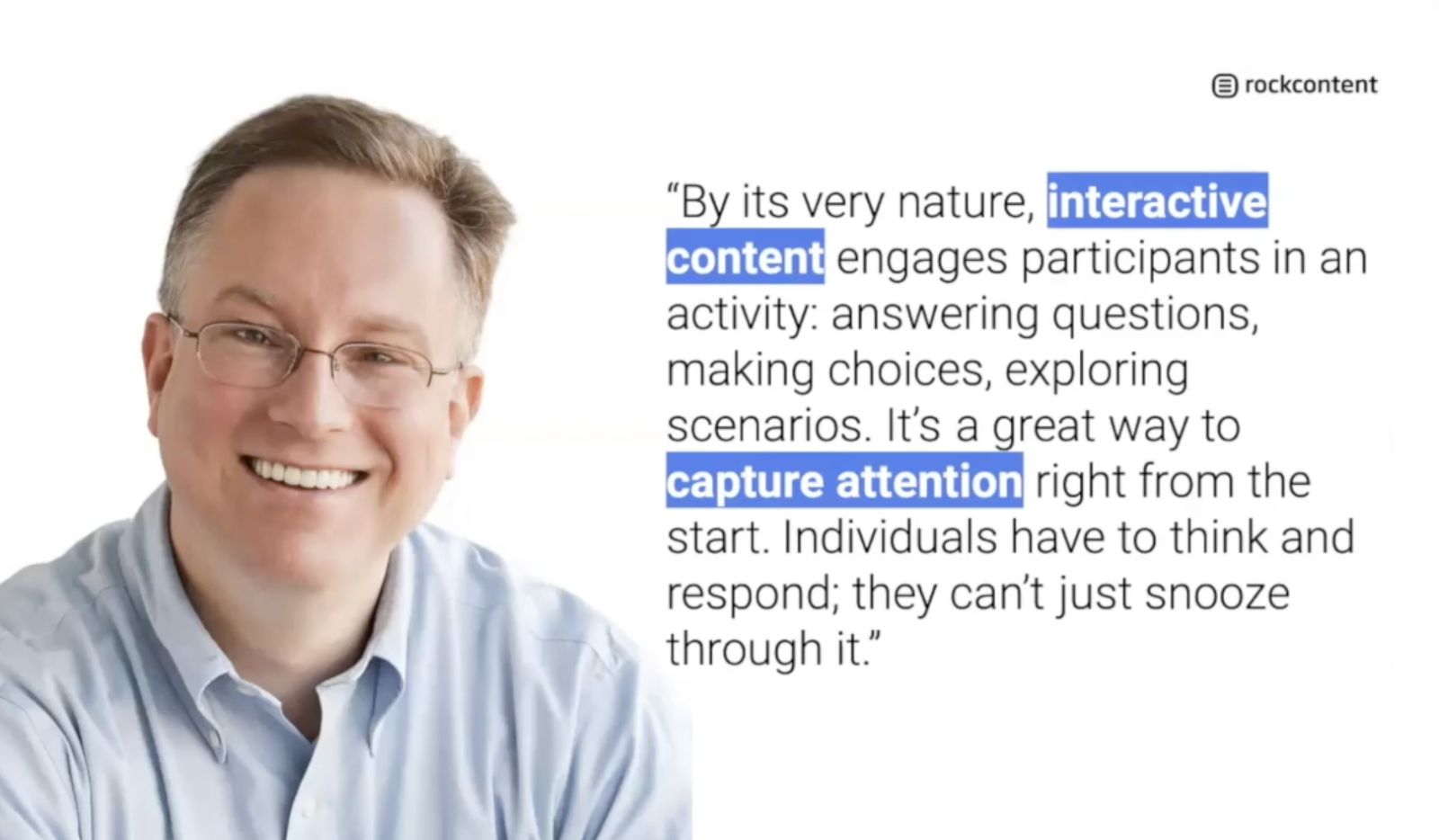
He's the VP of Platform at HubSpot and he says that interactive content engages participants in an activity: answering questions, making choices, exploring scenarios It's great to capture attention early on. Individuals have to think and respond it's not just skimming through content or just passively consuming.
5. The killer app for SaaS businesses: ROI calculators
To finish, I would like to share my favorite format for SaaS business, which I think is the killer app and any SaaS company should have one - the ROI calculator.
What is an ROI calculator?
It's used to measure the performance or potential gains or potential savings that your solution provides.
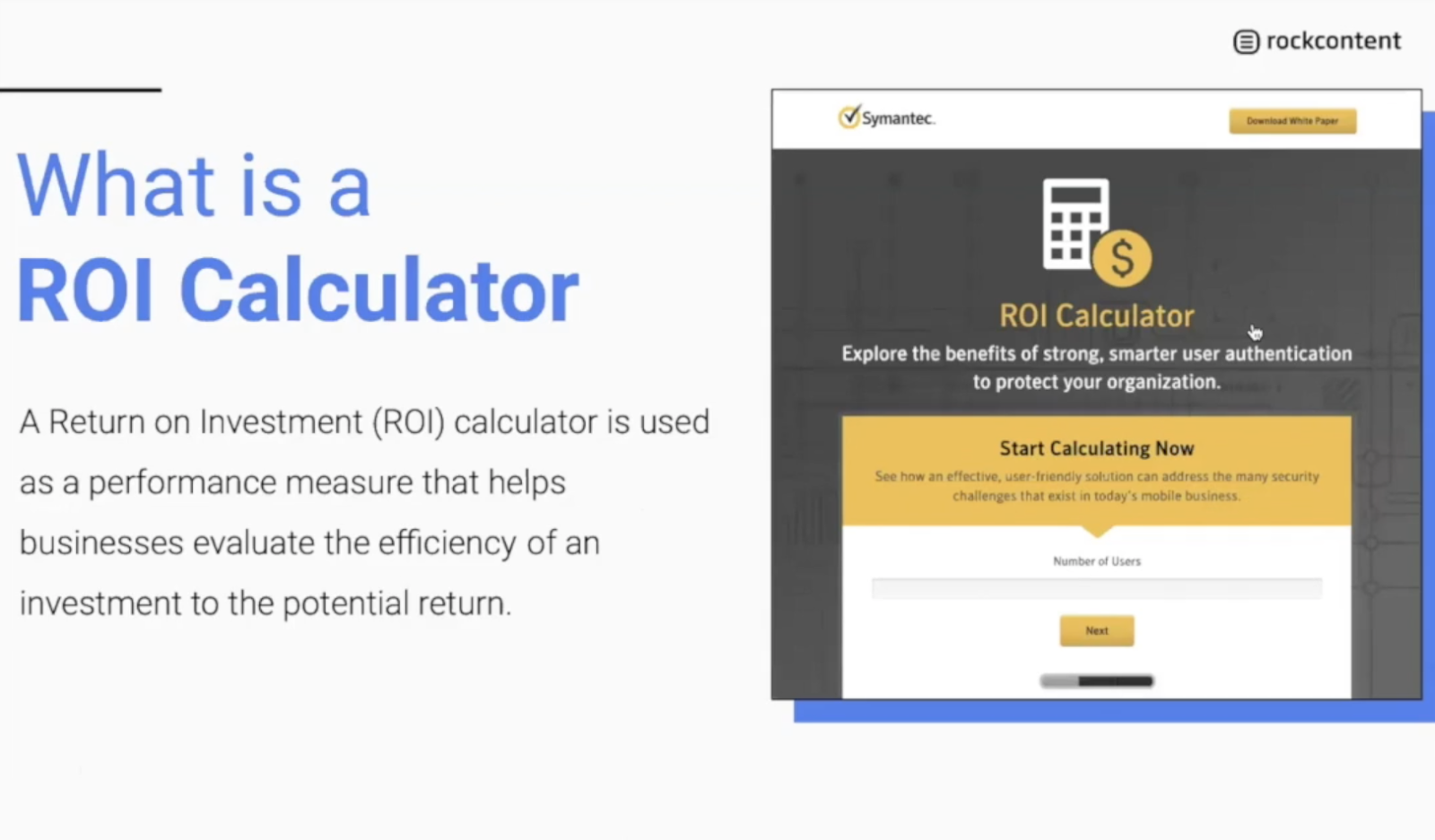
Here's one example of a Symantec ROI calculator.
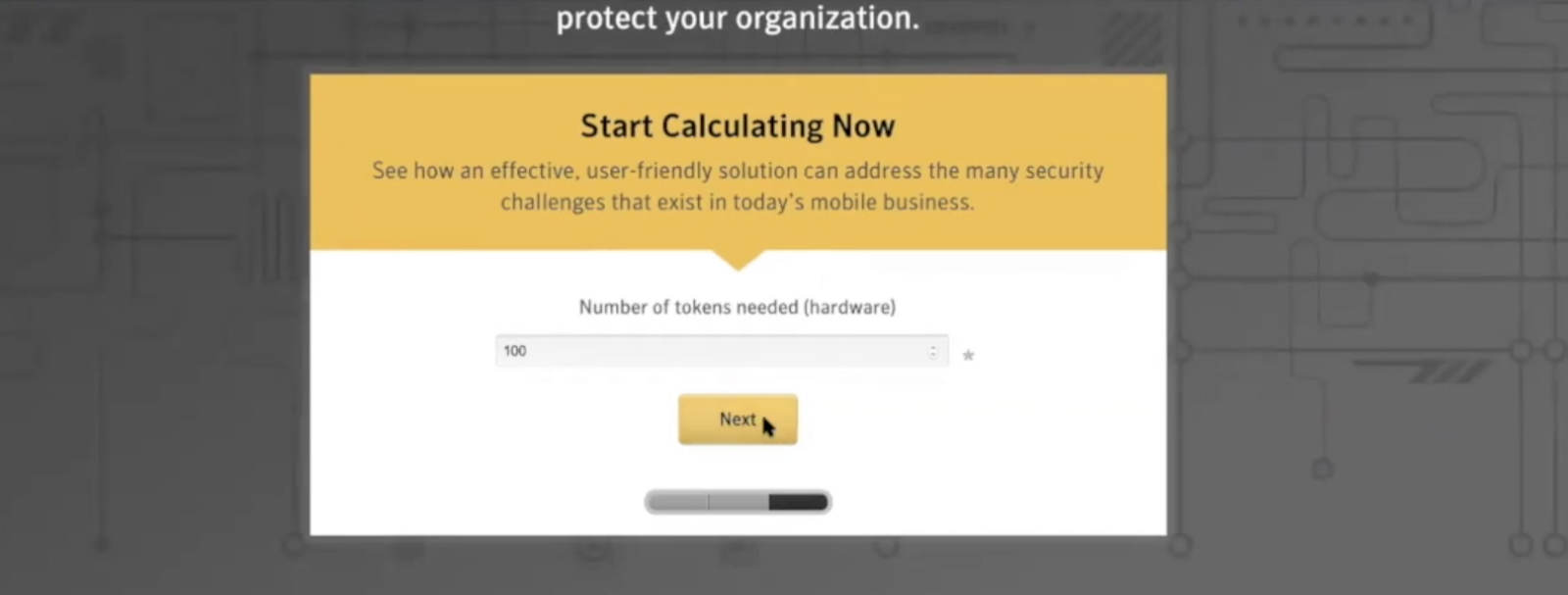
You will start entering your number of users and number of tokens, and you will see your potential results.
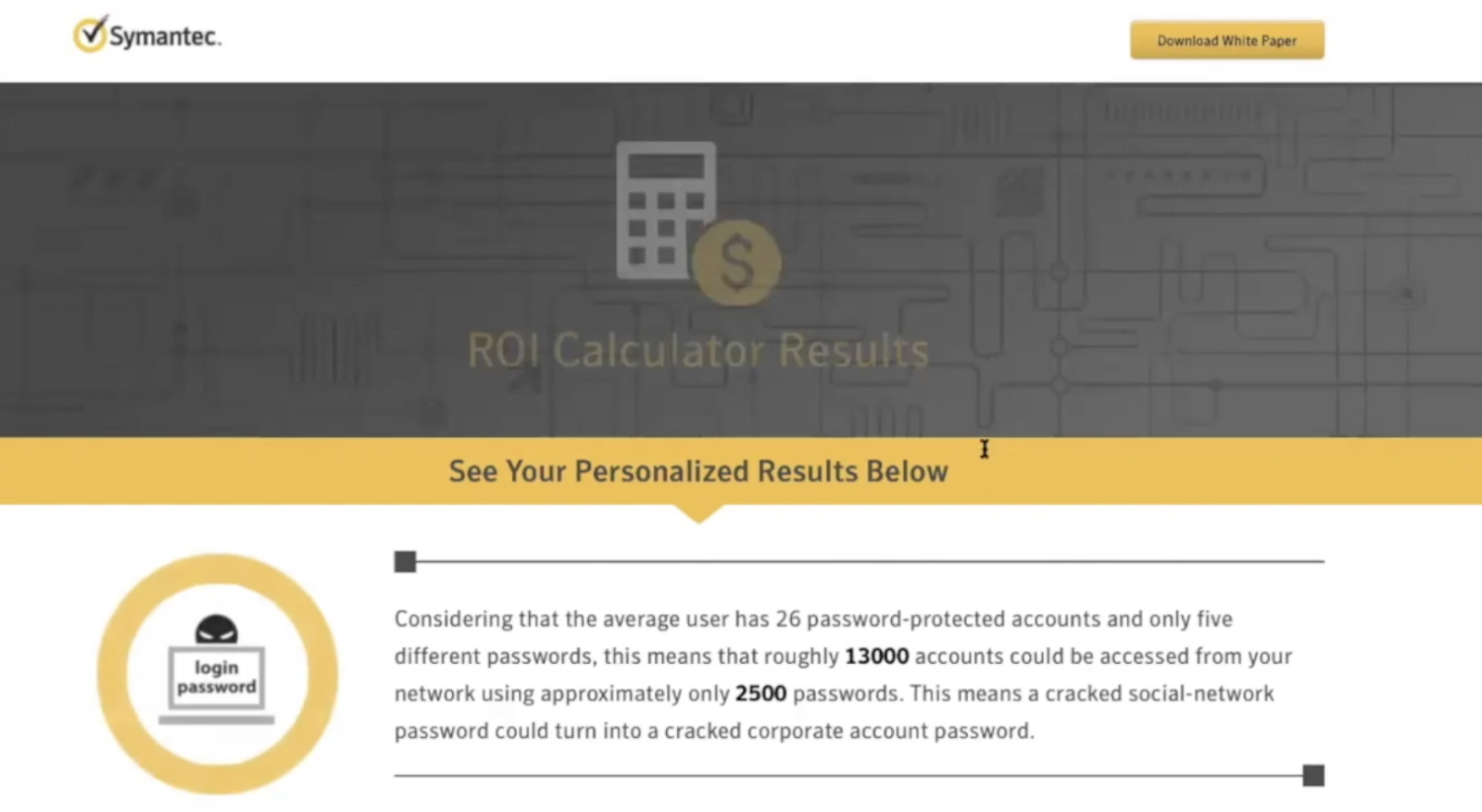
Every single metric on how it works, you can recalculate, all this data gets saved, salespeople will love you.
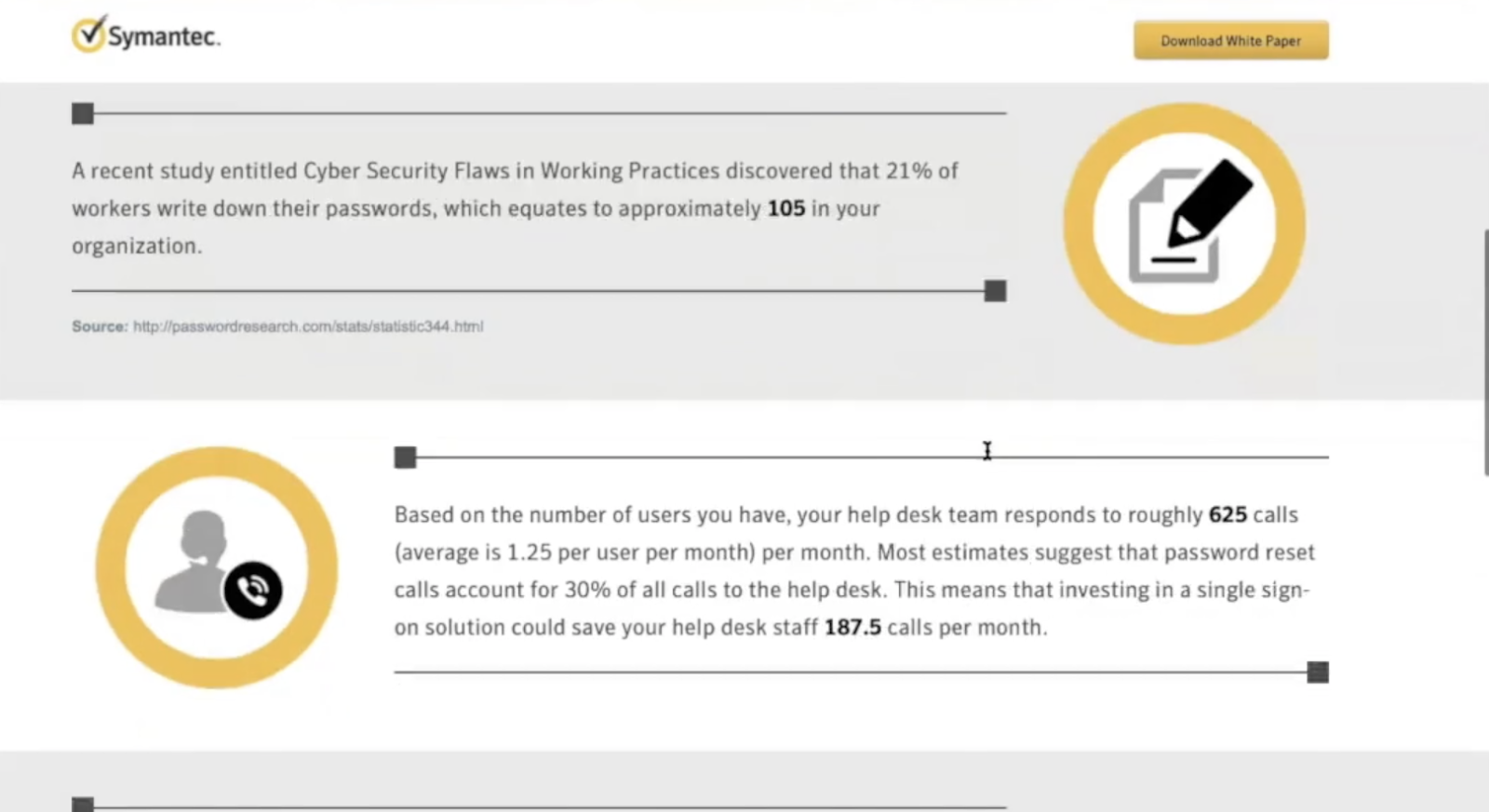
What should a SaaS business invest in building an ROI calculator now?
Why should you do it? Why should every SaaS company have their own ROI calculator?
Business benefits
Capture accurate information
The biggest benefit to the business is you capture accurate information, you can find out how much they spend on tools, what the challenges are with the tools, and how much time they spend doing manual processes.
Capture qualified leads
You can capture these very qualified leads, and you can identify which ones are the best fits for you.
Real time results
You can provide real-time value to your customer immediately. You can show how you compare to your competitors and to the status quo. It's really powerful.
Surface a wealth of information
The amount of data you can generate here, in a good sales rep’s hands, is massive. It's really impactful.
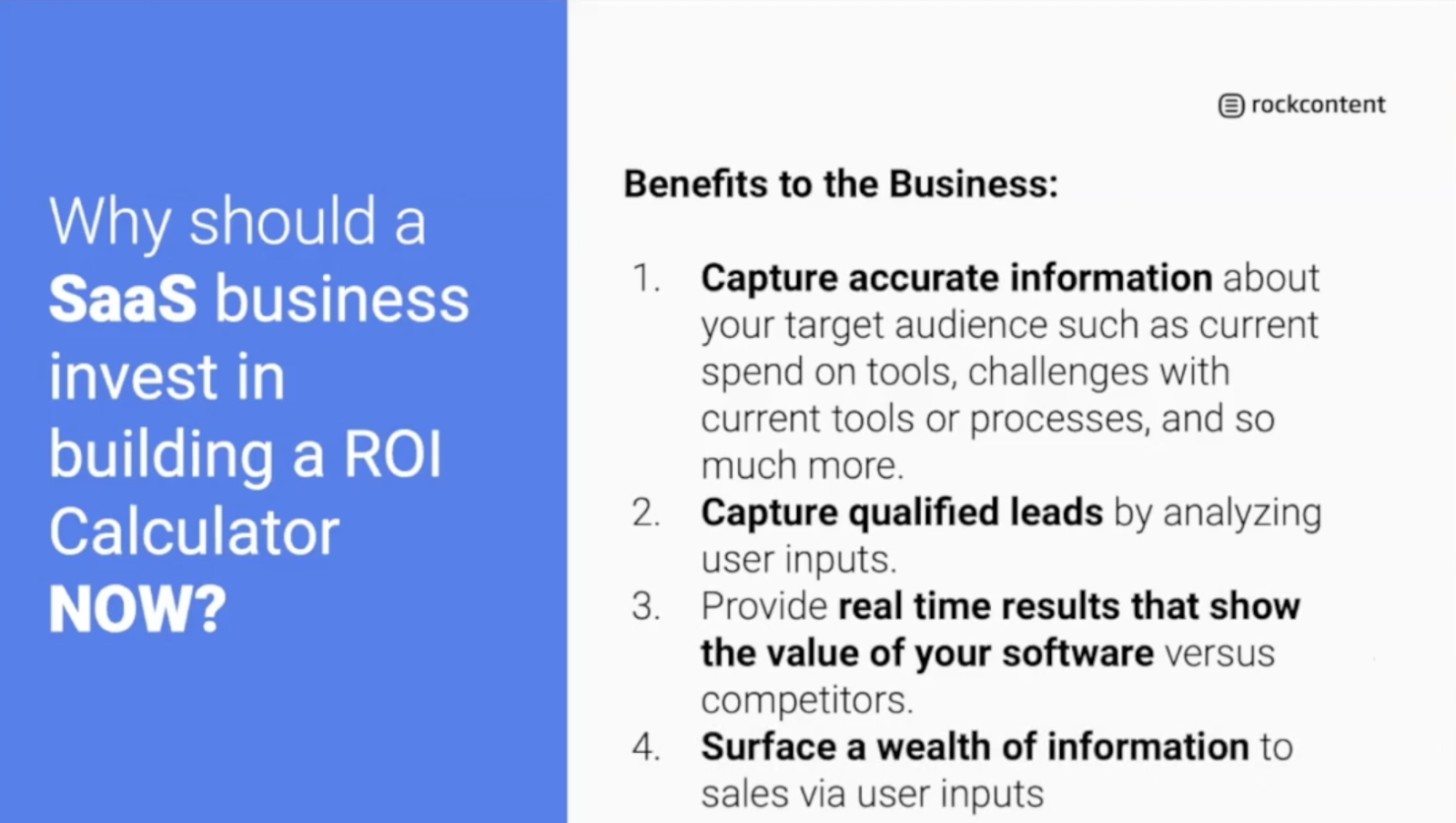
Pitney Bowes ROI calculator
One example here, a very classic, it's for the Pitney Bowes SendPro, a solution that simplifies shipping for a small business.
In real-time you calculate how much savings you can capture.
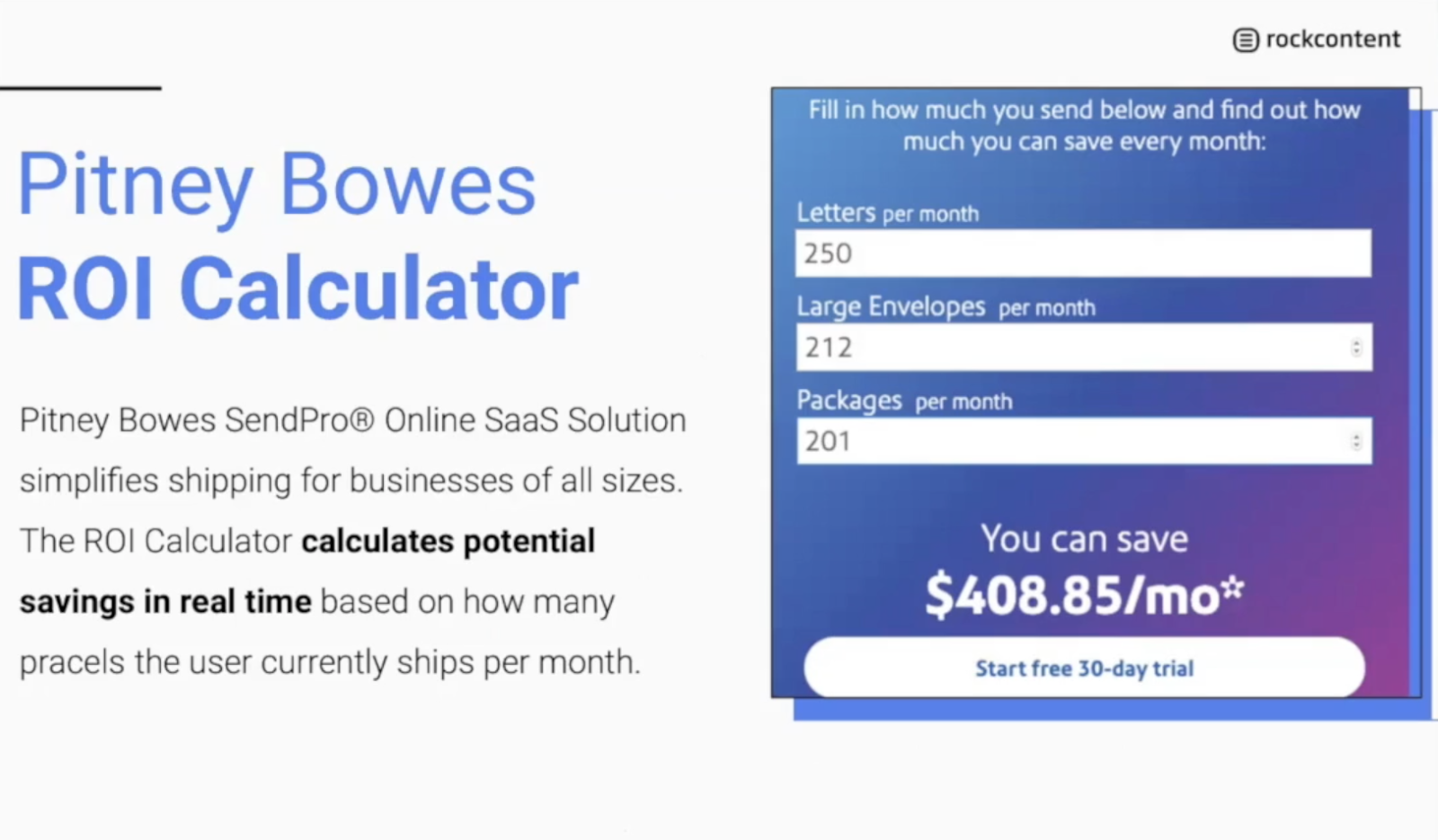
In this case, you send 250 letters per month, 212 large envelopes, and 201 packages. This solution saves you $400+ a month, and you can start your free trial now. That's very powerful because if the sales rep already knows the likely customer size, their level of pain, and the impact they can generate, the conversations get a lot richer.
Pro tip: ROI calculators are not limited to just showing cost savings
There's a very important tip when it comes to ROI calculators - do not think only about savings.
Future gain
Yes, savings are a powerful driver for SaaS purchases. But think about future gains.
- What will my customer’s life look like one year from now once he embraced my solution?
- What's he gaining?
Compete
Think about the competition. How do you stack up? If you're in a very competitive industry it's very good to show:
- This is who I am.
- This is how I am different.
- These are the results that I offer that my competitors do not.
Status quo
Also, think about the status quo.
- What's the cost of doing nothing?
- How many hours will your customers waste doing manual stuff that your platform does?
- How many times will they have to go to the post office to send packages in that example?
This is very important and the cost of doing nothing is a very powerful psychological tool for your sales team to leverage.
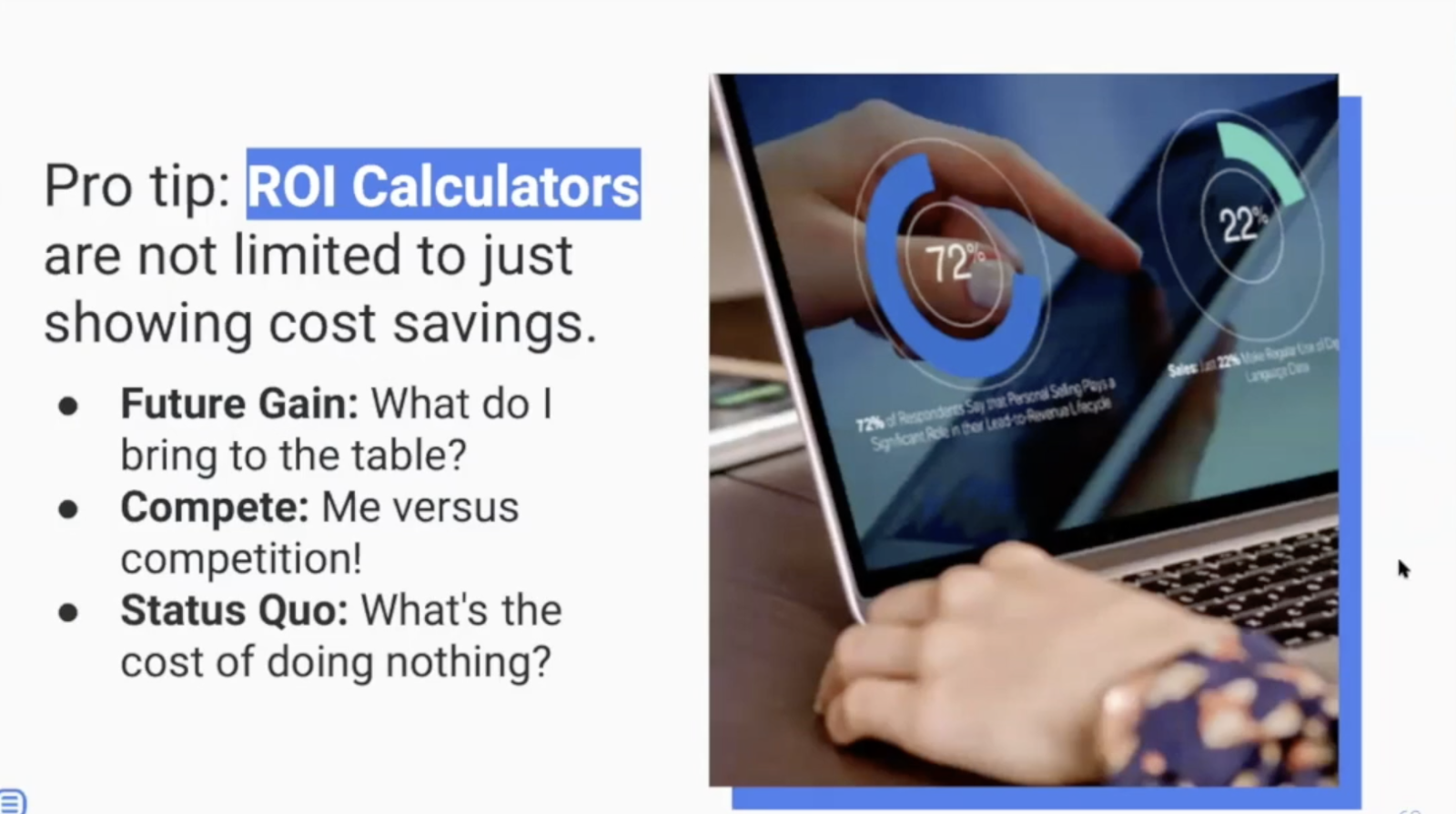
More examples
HubSpot ROI calculator
I really like the ROI calculator from HubSpot, you start entering in your monthly visitors, monthly leads, monthly customers, and your average selling price for customers.
Once you see that you get an estimate of the potential future gains.
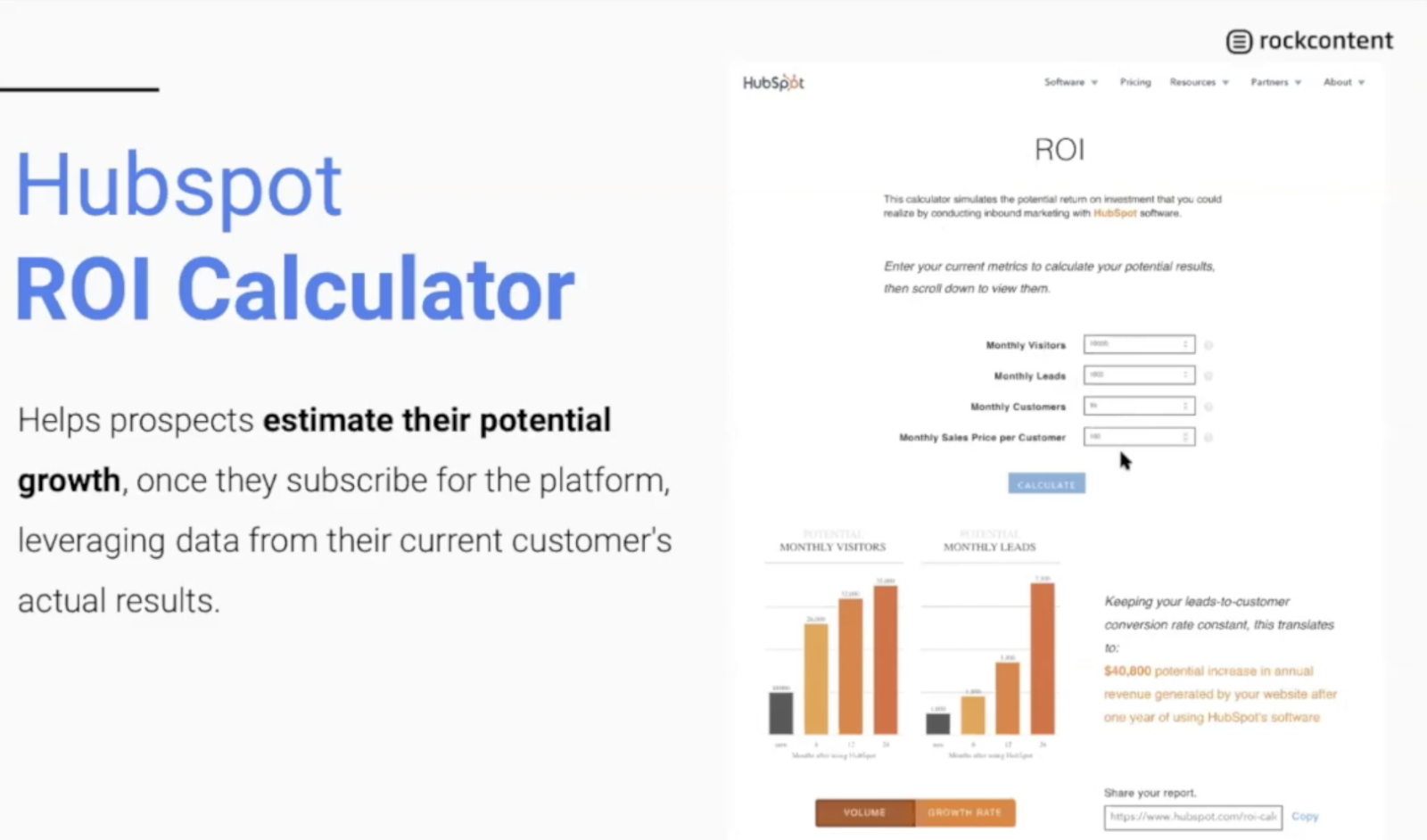
You could increase your funnel by $40,000 in annual revenue by using the HubSpot solution. It leverages past customer data and helps the potential customer estimate how the future will look for them.
Oracle ROI calculator
Coming back to Oracle, I really like their cloud estimator because not only is it a very rich experience, but it shows very clearly your estimated savings per month, what percentage, and it compares you in a very transparent manner with AWS, which is a competitor.
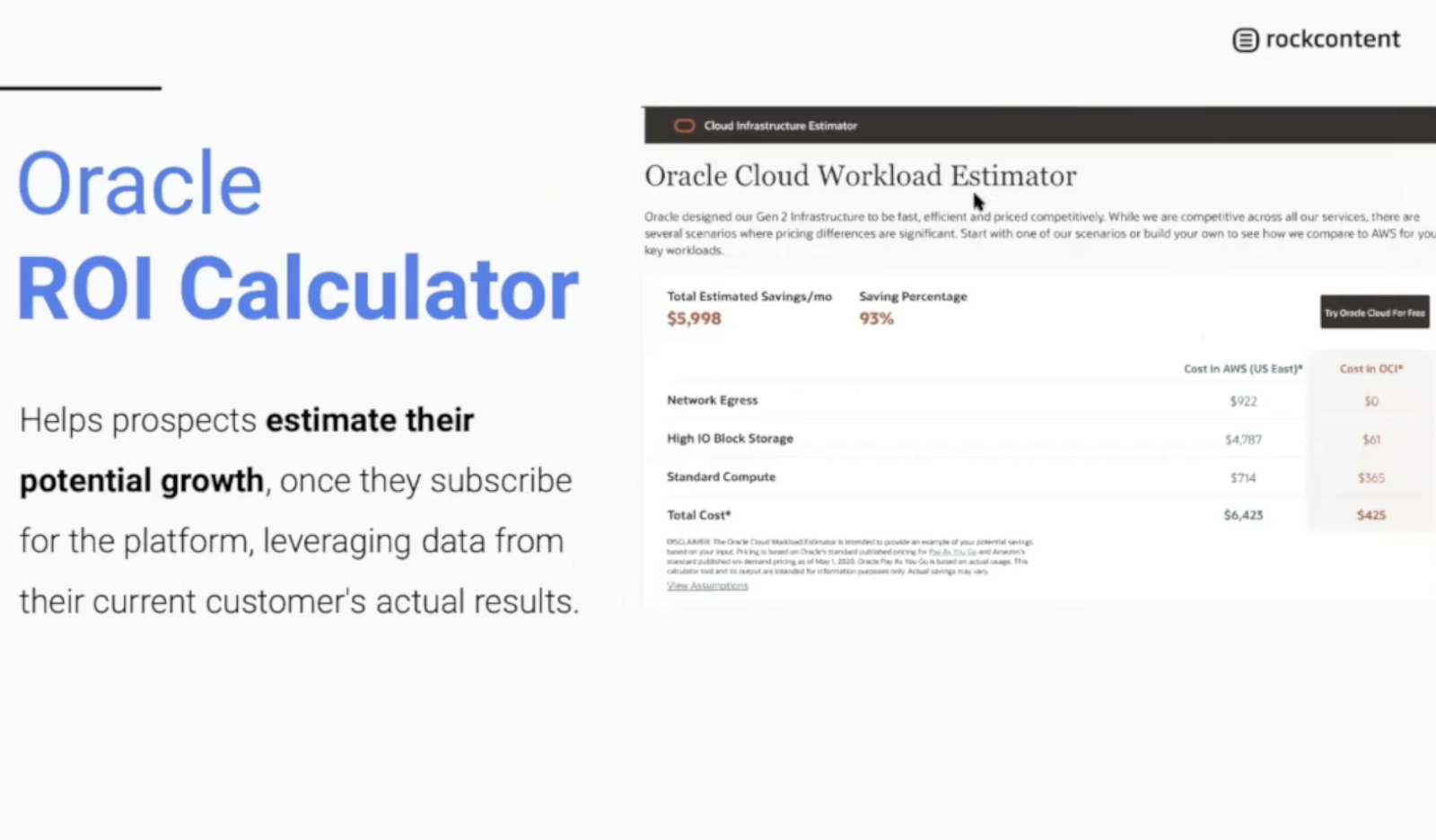
This is a great example of what interactive can do. It's something I think every SaaS business should be looking at.
TransferWise calculator
Another great one is the TransferWise calculator where you can compare your costs for doing a transaction with other banks, with their competitors, and they are super transparent here.
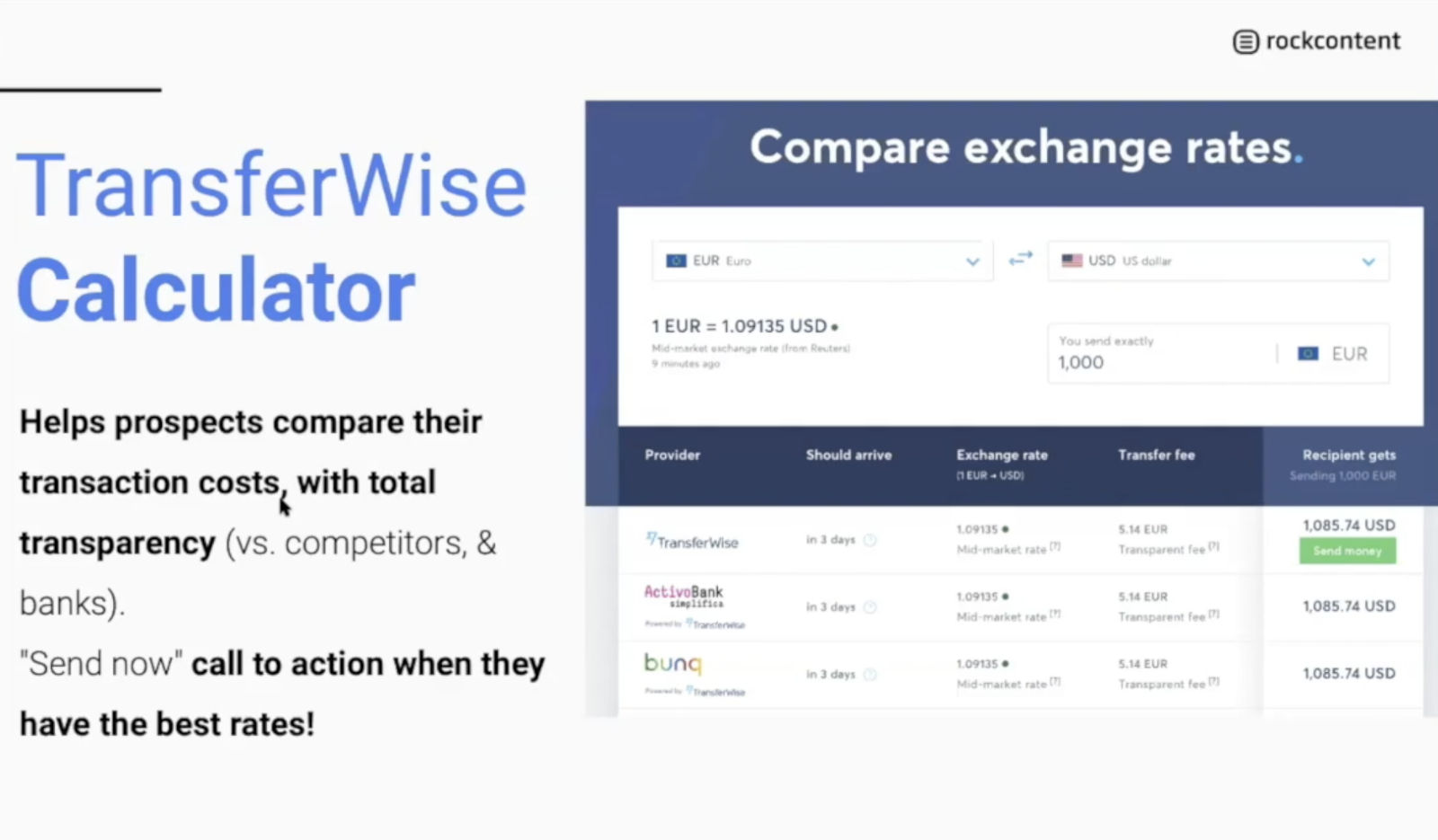
Sometimes they're not the cheapest, and they show that to you. I love it. And you also have this 'send money' call to action when they offer the best rates.
Key takeaways
Five simple IC rules
To finish up my key takeaways from today are five simple rules.
- Utility - interactive content has to provide immediate value to your prospect.
- Continuity - know where your customer lives, where he is right now in the journey, and use the best tool for the moment.
- Data-driven - ask and collect data but give this data back to the customer in the form of benchmarking, personalization, shortening the sales calls because your reps are more informed.
- Scale sales - interactive is very powerful to make your reps more productive. Engage them when creating new pieces of content.
- ROI calculators - just do it.
If you're a SaaS business, your prospects and your sales results will really thank me. These are the golden leads, the level of information you collect on this is amazing for your business. It increases your close rates a lot. It will be impactful.



